Female labour force participation in kenya PDF
VerifiedAdded on 2021/08/31
|26
|8105
|122
AI Summary
Contribute Materials
Your contribution can guide someone’s learning journey. Share your
documents today.
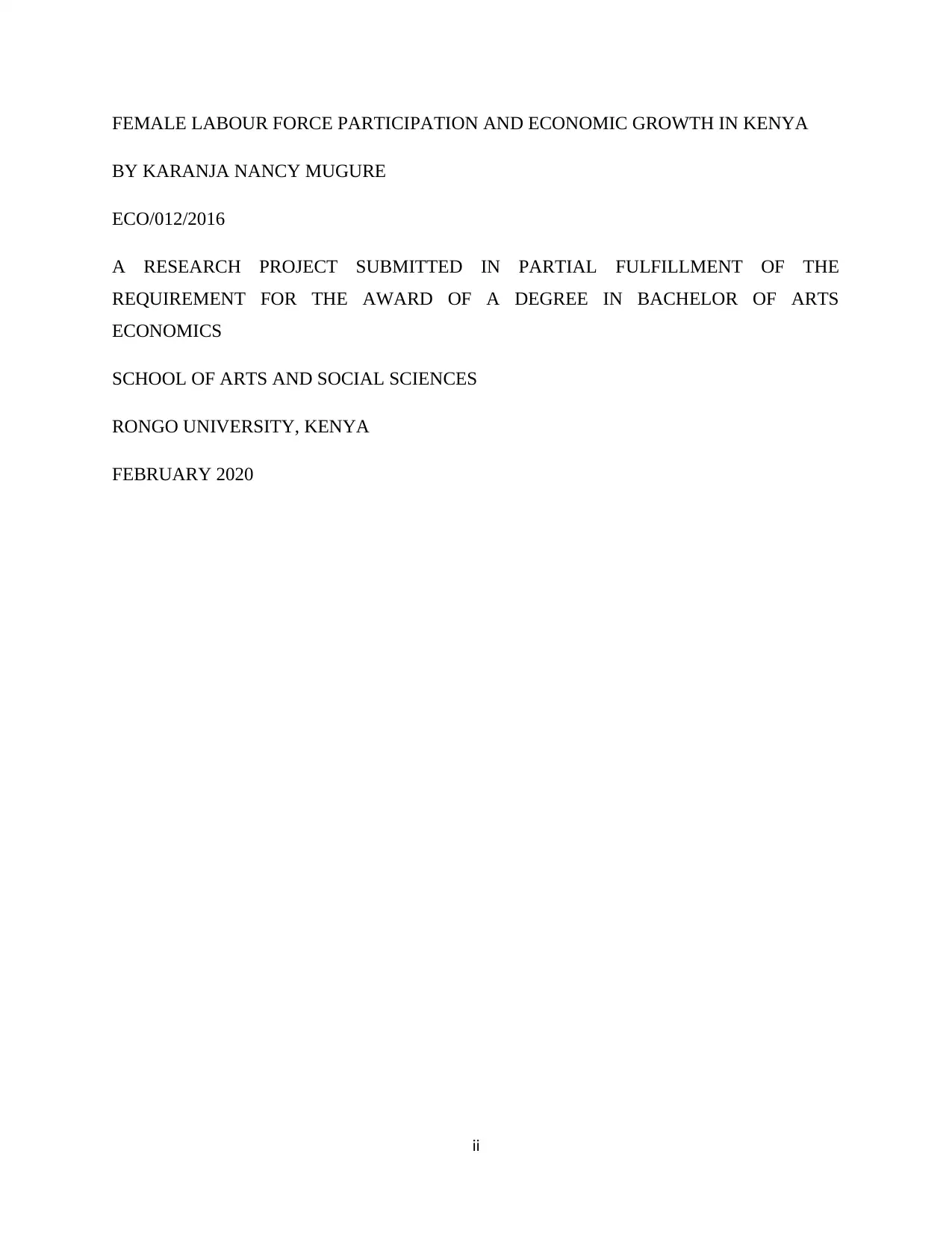
FEMALE LABOUR FORCE PARTICIPATION AND ECONOMIC GROWTH IN KENYA
BY KARANJA NANCY MUGURE
ECO/012/2016
A RESEARCH PROJECT SUBMITTED IN PARTIAL FULFILLMENT OF THE
REQUIREMENT FOR THE AWARD OF A DEGREE IN BACHELOR OF ARTS
ECONOMICS
SCHOOL OF ARTS AND SOCIAL SCIENCES
RONGO UNIVERSITY, KENYA
FEBRUARY 2020
ii
BY KARANJA NANCY MUGURE
ECO/012/2016
A RESEARCH PROJECT SUBMITTED IN PARTIAL FULFILLMENT OF THE
REQUIREMENT FOR THE AWARD OF A DEGREE IN BACHELOR OF ARTS
ECONOMICS
SCHOOL OF ARTS AND SOCIAL SCIENCES
RONGO UNIVERSITY, KENYA
FEBRUARY 2020
ii
Secure Best Marks with AI Grader
Need help grading? Try our AI Grader for instant feedback on your assignments.

DECLARATION
I Nancy Mugure Karanja declare that this project is my own personal work and has been done
to the best of my knowledge and ability. I hereby declare that all information on this document
has been obtained and presented in accordance with academic rules and ethical conduct.
Name: Nancy Mugure Karanja Registration No.: ECO/012/2016
Signature:
Supervisor’s name: Mr Moses Obama Position: Lecturer
Signature:
iii
I Nancy Mugure Karanja declare that this project is my own personal work and has been done
to the best of my knowledge and ability. I hereby declare that all information on this document
has been obtained and presented in accordance with academic rules and ethical conduct.
Name: Nancy Mugure Karanja Registration No.: ECO/012/2016
Signature:
Supervisor’s name: Mr Moses Obama Position: Lecturer
Signature:
iii
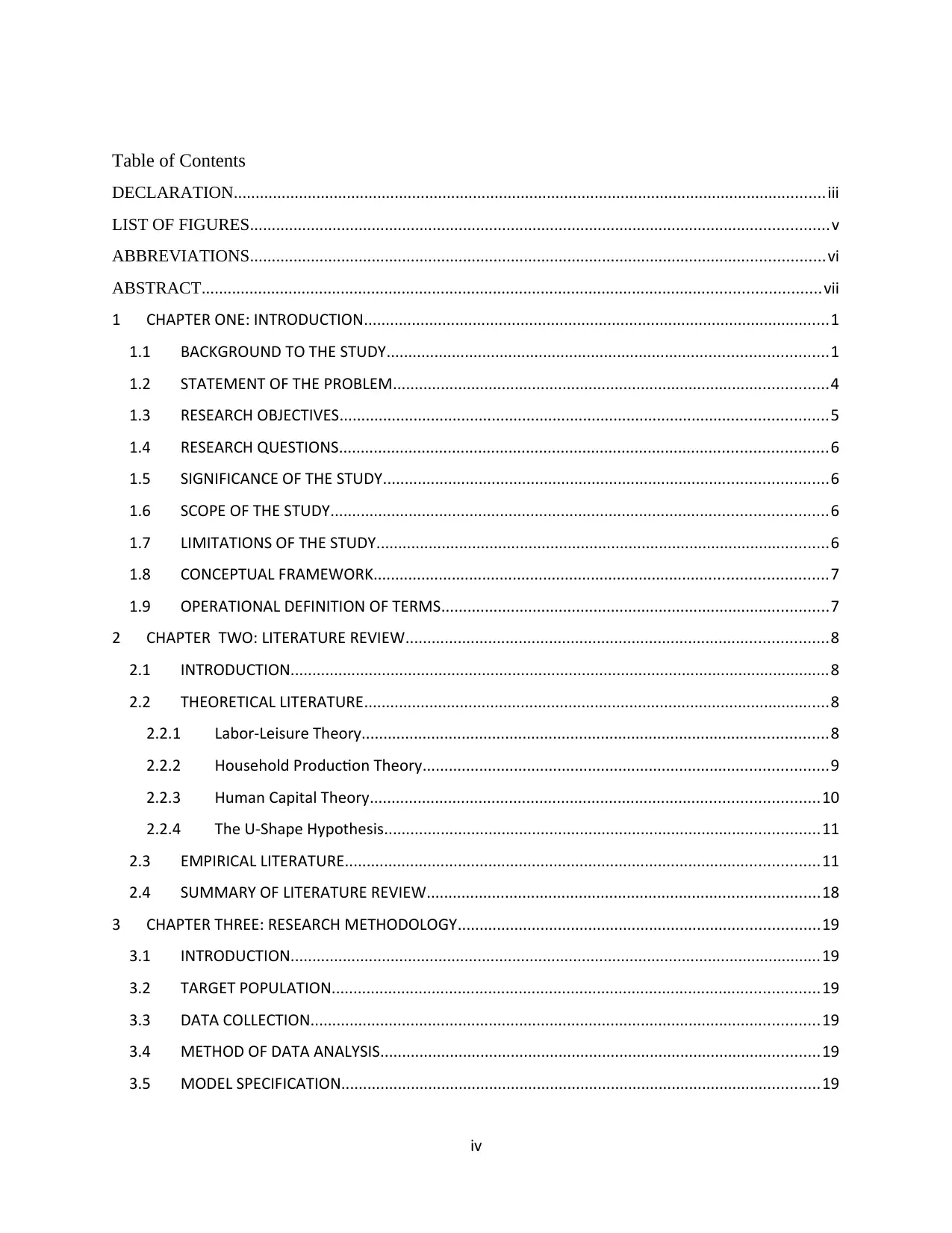
Table of Contents
DECLARATION........................................................................................................................................iii
LIST OF FIGURES.....................................................................................................................................v
ABBREVIATIONS....................................................................................................................................vi
ABSTRACT..............................................................................................................................................vii
1 CHAPTER ONE: INTRODUCTION...........................................................................................................1
1.1 BACKGROUND TO THE STUDY.....................................................................................................1
1.2 STATEMENT OF THE PROBLEM....................................................................................................4
1.3 RESEARCH OBJECTIVES................................................................................................................5
1.4 RESEARCH QUESTIONS................................................................................................................6
1.5 SIGNIFICANCE OF THE STUDY......................................................................................................6
1.6 SCOPE OF THE STUDY..................................................................................................................6
1.7 LIMITATIONS OF THE STUDY........................................................................................................6
1.8 CONCEPTUAL FRAMEWORK........................................................................................................7
1.9 OPERATIONAL DEFINITION OF TERMS.........................................................................................7
2 CHAPTER TWO: LITERATURE REVIEW.................................................................................................8
2.1 INTRODUCTION............................................................................................................................8
2.2 THEORETICAL LITERATURE...........................................................................................................8
2.2.1 Labor-Leisure Theory...........................................................................................................8
2.2.2 Household Production Theory.............................................................................................9
2.2.3 Human Capital Theory.......................................................................................................10
2.2.4 The U-Shape Hypothesis....................................................................................................11
2.3 EMPIRICAL LITERATURE.............................................................................................................11
2.4 SUMMARY OF LITERATURE REVIEW..........................................................................................18
3 CHAPTER THREE: RESEARCH METHODOLOGY...................................................................................19
3.1 INTRODUCTION..........................................................................................................................19
3.2 TARGET POPULATION................................................................................................................19
3.3 DATA COLLECTION.....................................................................................................................19
3.4 METHOD OF DATA ANALYSIS.....................................................................................................19
3.5 MODEL SPECIFICATION..............................................................................................................19
iv
DECLARATION........................................................................................................................................iii
LIST OF FIGURES.....................................................................................................................................v
ABBREVIATIONS....................................................................................................................................vi
ABSTRACT..............................................................................................................................................vii
1 CHAPTER ONE: INTRODUCTION...........................................................................................................1
1.1 BACKGROUND TO THE STUDY.....................................................................................................1
1.2 STATEMENT OF THE PROBLEM....................................................................................................4
1.3 RESEARCH OBJECTIVES................................................................................................................5
1.4 RESEARCH QUESTIONS................................................................................................................6
1.5 SIGNIFICANCE OF THE STUDY......................................................................................................6
1.6 SCOPE OF THE STUDY..................................................................................................................6
1.7 LIMITATIONS OF THE STUDY........................................................................................................6
1.8 CONCEPTUAL FRAMEWORK........................................................................................................7
1.9 OPERATIONAL DEFINITION OF TERMS.........................................................................................7
2 CHAPTER TWO: LITERATURE REVIEW.................................................................................................8
2.1 INTRODUCTION............................................................................................................................8
2.2 THEORETICAL LITERATURE...........................................................................................................8
2.2.1 Labor-Leisure Theory...........................................................................................................8
2.2.2 Household Production Theory.............................................................................................9
2.2.3 Human Capital Theory.......................................................................................................10
2.2.4 The U-Shape Hypothesis....................................................................................................11
2.3 EMPIRICAL LITERATURE.............................................................................................................11
2.4 SUMMARY OF LITERATURE REVIEW..........................................................................................18
3 CHAPTER THREE: RESEARCH METHODOLOGY...................................................................................19
3.1 INTRODUCTION..........................................................................................................................19
3.2 TARGET POPULATION................................................................................................................19
3.3 DATA COLLECTION.....................................................................................................................19
3.4 METHOD OF DATA ANALYSIS.....................................................................................................19
3.5 MODEL SPECIFICATION..............................................................................................................19
iv
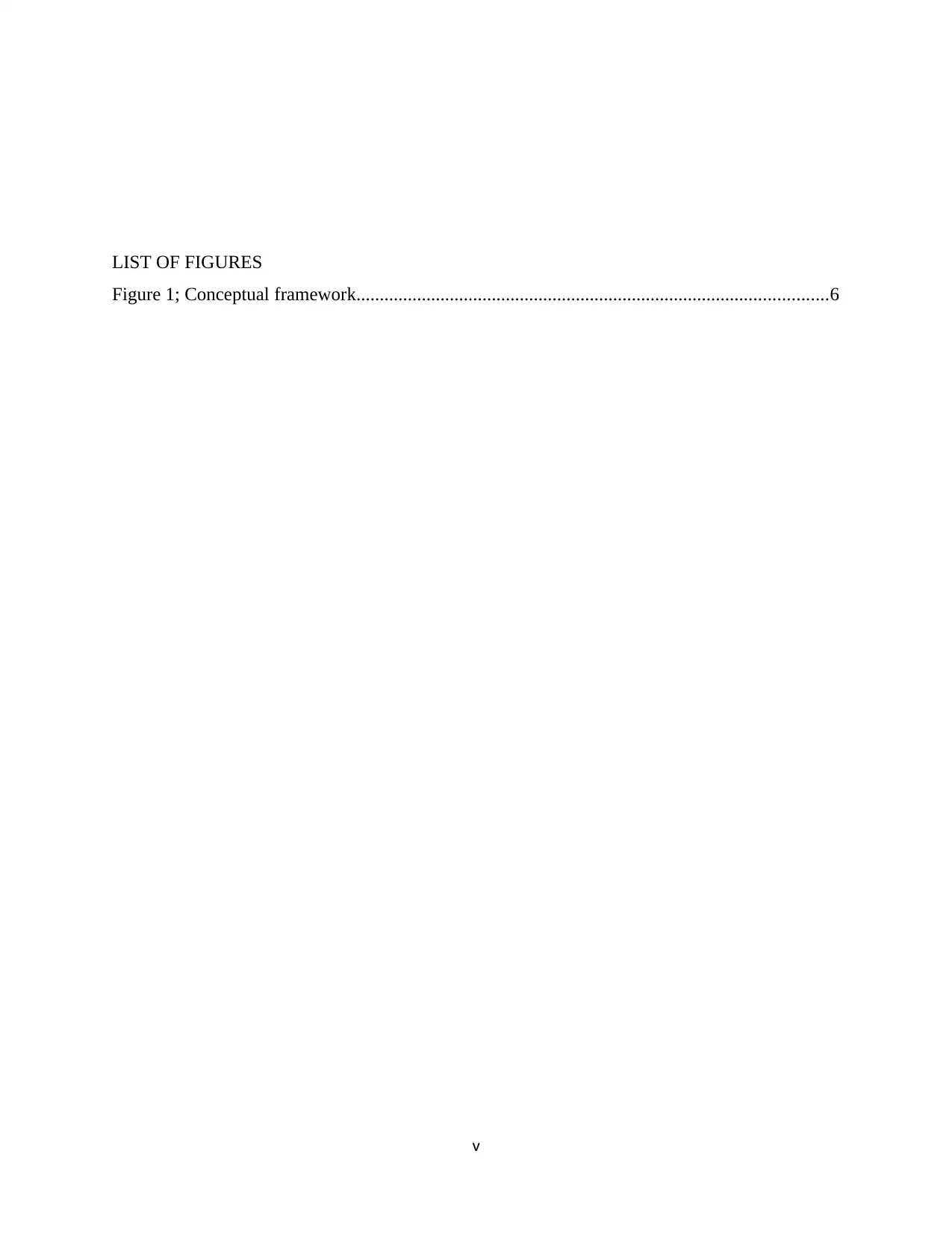
LIST OF FIGURES
Figure 1; Conceptual framework.....................................................................................................6
v
Figure 1; Conceptual framework.....................................................................................................6
v
Secure Best Marks with AI Grader
Need help grading? Try our AI Grader for instant feedback on your assignments.
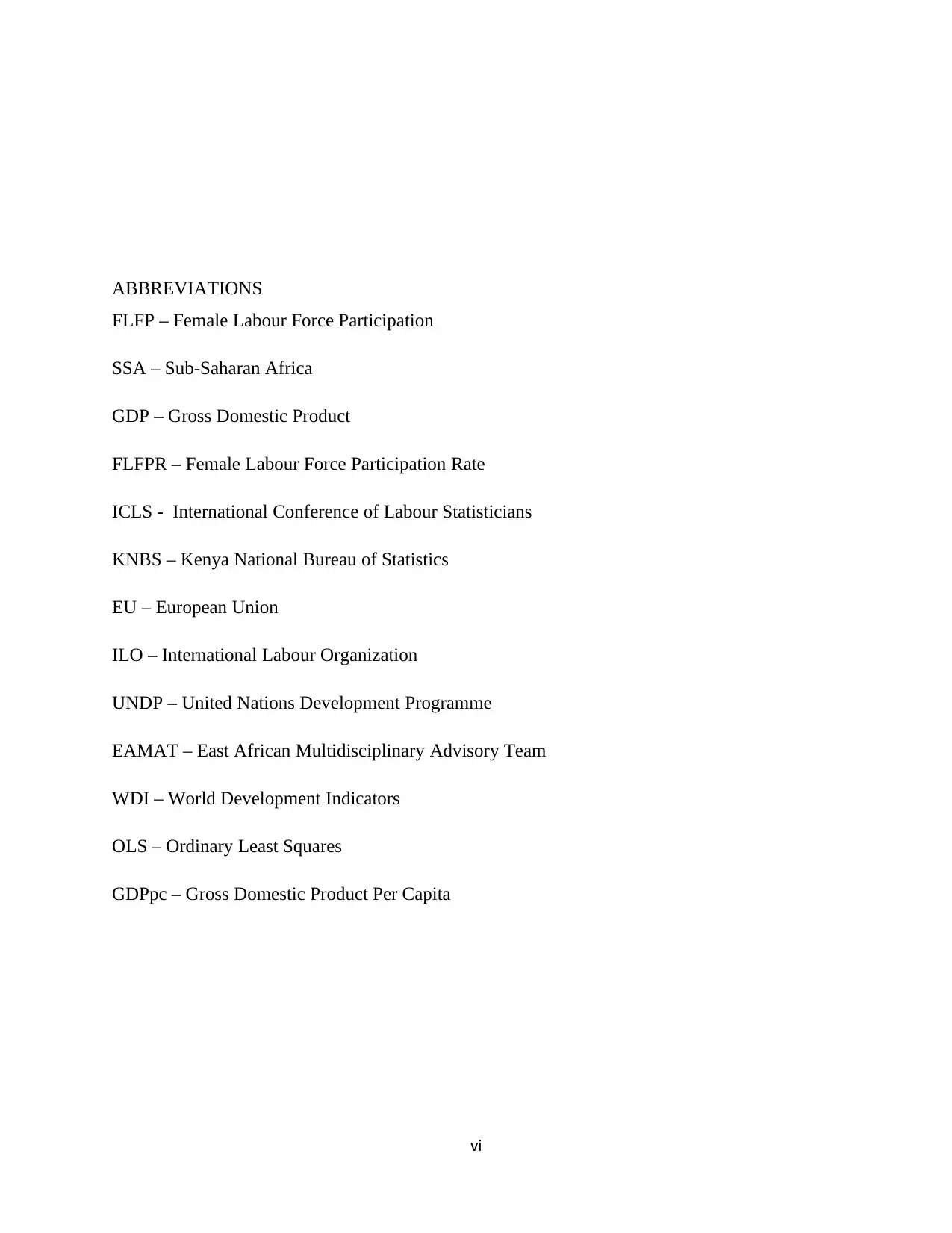
ABBREVIATIONS
FLFP – Female Labour Force Participation
SSA – Sub-Saharan Africa
GDP – Gross Domestic Product
FLFPR – Female Labour Force Participation Rate
ICLS - International Conference of Labour Statisticians
KNBS – Kenya National Bureau of Statistics
EU – European Union
ILO – International Labour Organization
UNDP – United Nations Development Programme
EAMAT – East African Multidisciplinary Advisory Team
WDI – World Development Indicators
OLS – Ordinary Least Squares
GDPpc – Gross Domestic Product Per Capita
vi
FLFP – Female Labour Force Participation
SSA – Sub-Saharan Africa
GDP – Gross Domestic Product
FLFPR – Female Labour Force Participation Rate
ICLS - International Conference of Labour Statisticians
KNBS – Kenya National Bureau of Statistics
EU – European Union
ILO – International Labour Organization
UNDP – United Nations Development Programme
EAMAT – East African Multidisciplinary Advisory Team
WDI – World Development Indicators
OLS – Ordinary Least Squares
GDPpc – Gross Domestic Product Per Capita
vi
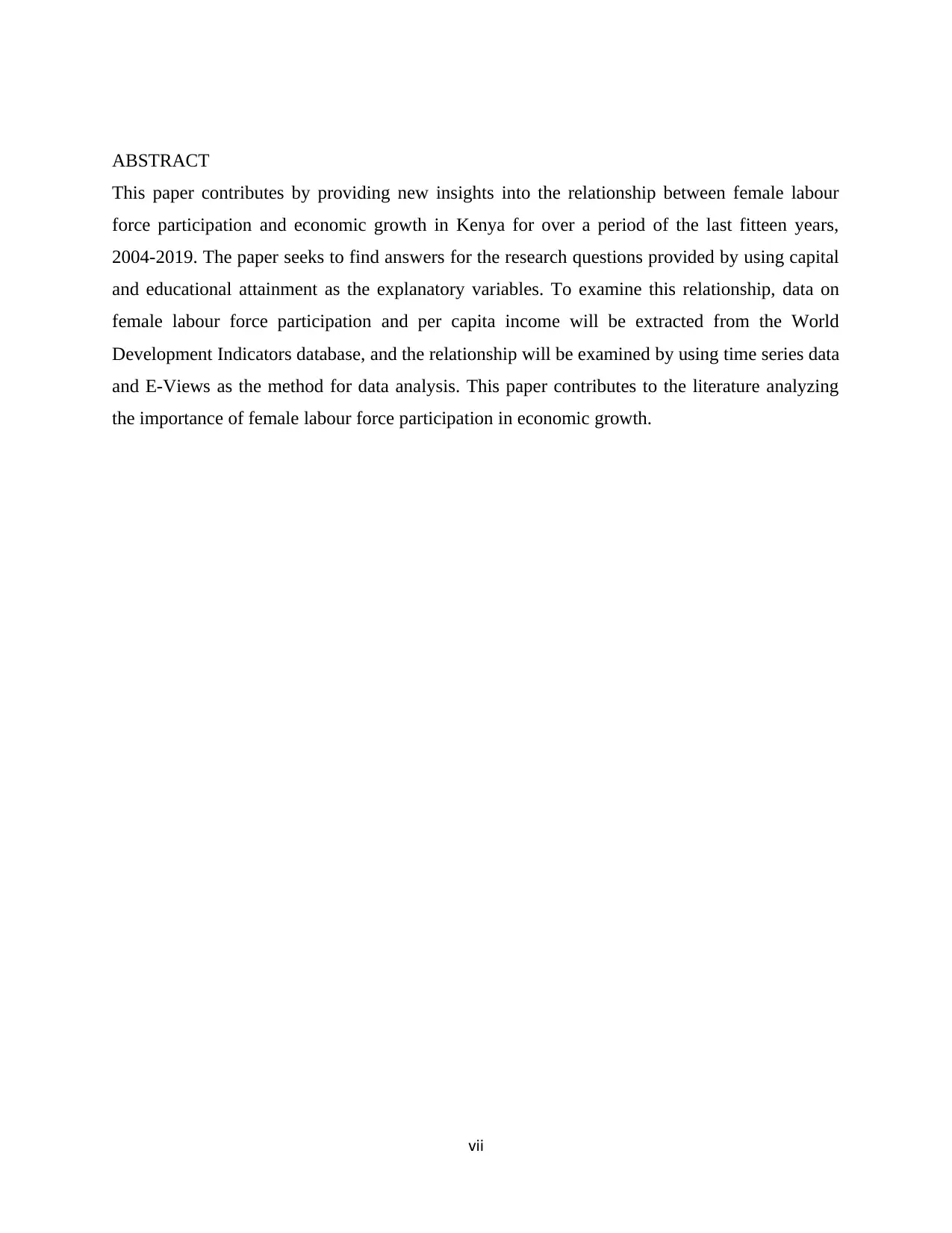
ABSTRACT
This paper contributes by providing new insights into the relationship between female labour
force participation and economic growth in Kenya for over a period of the last fitteen years,
2004-2019. The paper seeks to find answers for the research questions provided by using capital
and educational attainment as the explanatory variables. To examine this relationship, data on
female labour force participation and per capita income will be extracted from the World
Development Indicators database, and the relationship will be examined by using time series data
and E-Views as the method for data analysis. This paper contributes to the literature analyzing
the importance of female labour force participation in economic growth.
vii
This paper contributes by providing new insights into the relationship between female labour
force participation and economic growth in Kenya for over a period of the last fitteen years,
2004-2019. The paper seeks to find answers for the research questions provided by using capital
and educational attainment as the explanatory variables. To examine this relationship, data on
female labour force participation and per capita income will be extracted from the World
Development Indicators database, and the relationship will be examined by using time series data
and E-Views as the method for data analysis. This paper contributes to the literature analyzing
the importance of female labour force participation in economic growth.
vii
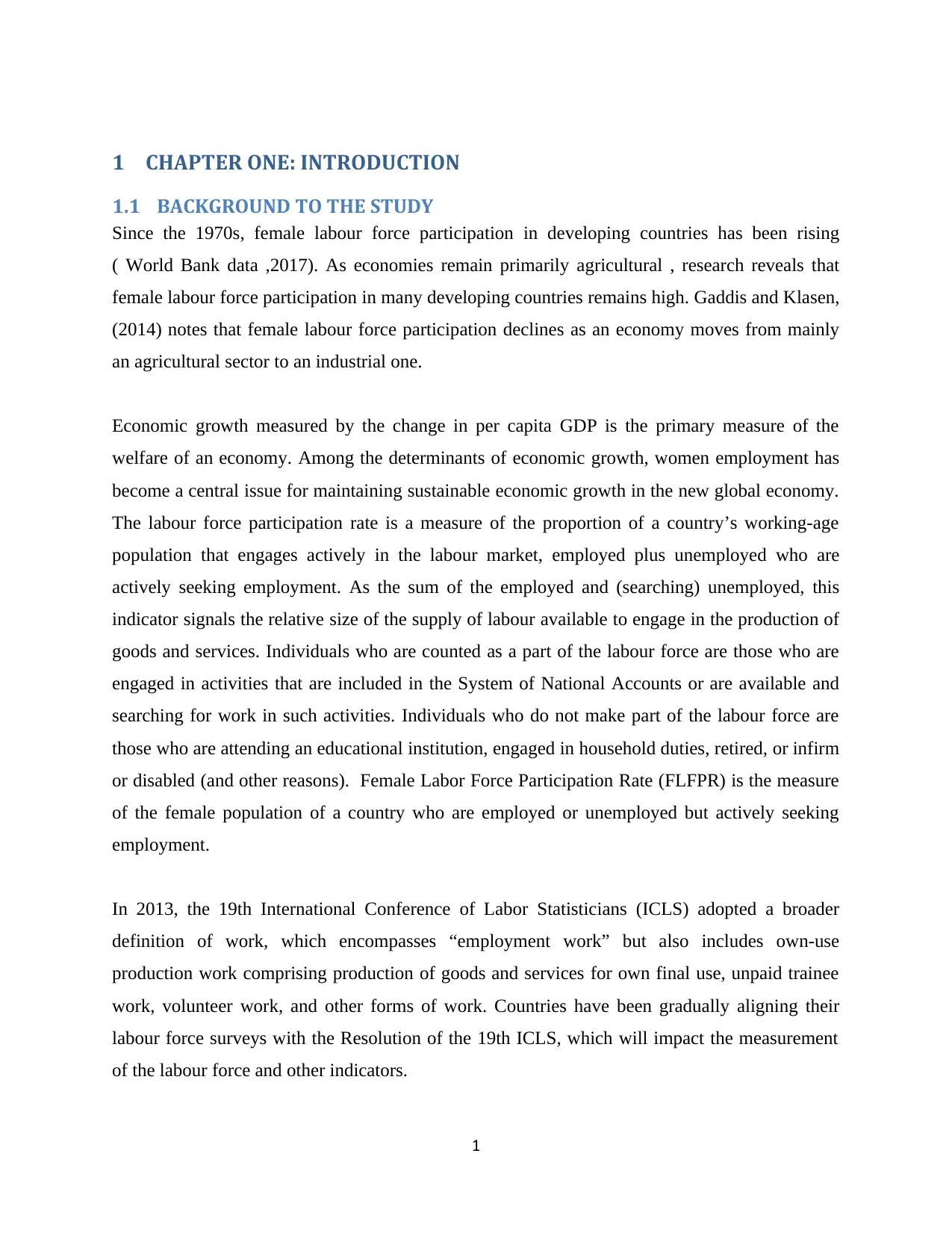
1 CHAPTER ONE: INTRODUCTION
1.1 BACKGROUND TO THE STUDY
Since the 1970s, female labour force participation in developing countries has been rising
( World Bank data ,2017). As economies remain primarily agricultural , research reveals that
female labour force participation in many developing countries remains high. Gaddis and Klasen,
(2014) notes that female labour force participation declines as an economy moves from mainly
an agricultural sector to an industrial one.
Economic growth measured by the change in per capita GDP is the primary measure of the
welfare of an economy. Among the determinants of economic growth, women employment has
become a central issue for maintaining sustainable economic growth in the new global economy.
The labour force participation rate is a measure of the proportion of a country’s working-age
population that engages actively in the labour market, employed plus unemployed who are
actively seeking employment. As the sum of the employed and (searching) unemployed, this
indicator signals the relative size of the supply of labour available to engage in the production of
goods and services. Individuals who are counted as a part of the labour force are those who are
engaged in activities that are included in the System of National Accounts or are available and
searching for work in such activities. Individuals who do not make part of the labour force are
those who are attending an educational institution, engaged in household duties, retired, or infirm
or disabled (and other reasons). Female Labor Force Participation Rate (FLFPR) is the measure
of the female population of a country who are employed or unemployed but actively seeking
employment.
In 2013, the 19th International Conference of Labor Statisticians (ICLS) adopted a broader
definition of work, which encompasses “employment work” but also includes own-use
production work comprising production of goods and services for own final use, unpaid trainee
work, volunteer work, and other forms of work. Countries have been gradually aligning their
labour force surveys with the Resolution of the 19th ICLS, which will impact the measurement
of the labour force and other indicators.
1
1.1 BACKGROUND TO THE STUDY
Since the 1970s, female labour force participation in developing countries has been rising
( World Bank data ,2017). As economies remain primarily agricultural , research reveals that
female labour force participation in many developing countries remains high. Gaddis and Klasen,
(2014) notes that female labour force participation declines as an economy moves from mainly
an agricultural sector to an industrial one.
Economic growth measured by the change in per capita GDP is the primary measure of the
welfare of an economy. Among the determinants of economic growth, women employment has
become a central issue for maintaining sustainable economic growth in the new global economy.
The labour force participation rate is a measure of the proportion of a country’s working-age
population that engages actively in the labour market, employed plus unemployed who are
actively seeking employment. As the sum of the employed and (searching) unemployed, this
indicator signals the relative size of the supply of labour available to engage in the production of
goods and services. Individuals who are counted as a part of the labour force are those who are
engaged in activities that are included in the System of National Accounts or are available and
searching for work in such activities. Individuals who do not make part of the labour force are
those who are attending an educational institution, engaged in household duties, retired, or infirm
or disabled (and other reasons). Female Labor Force Participation Rate (FLFPR) is the measure
of the female population of a country who are employed or unemployed but actively seeking
employment.
In 2013, the 19th International Conference of Labor Statisticians (ICLS) adopted a broader
definition of work, which encompasses “employment work” but also includes own-use
production work comprising production of goods and services for own final use, unpaid trainee
work, volunteer work, and other forms of work. Countries have been gradually aligning their
labour force surveys with the Resolution of the 19th ICLS, which will impact the measurement
of the labour force and other indicators.
1
Paraphrase This Document
Need a fresh take? Get an instant paraphrase of this document with our AI Paraphraser
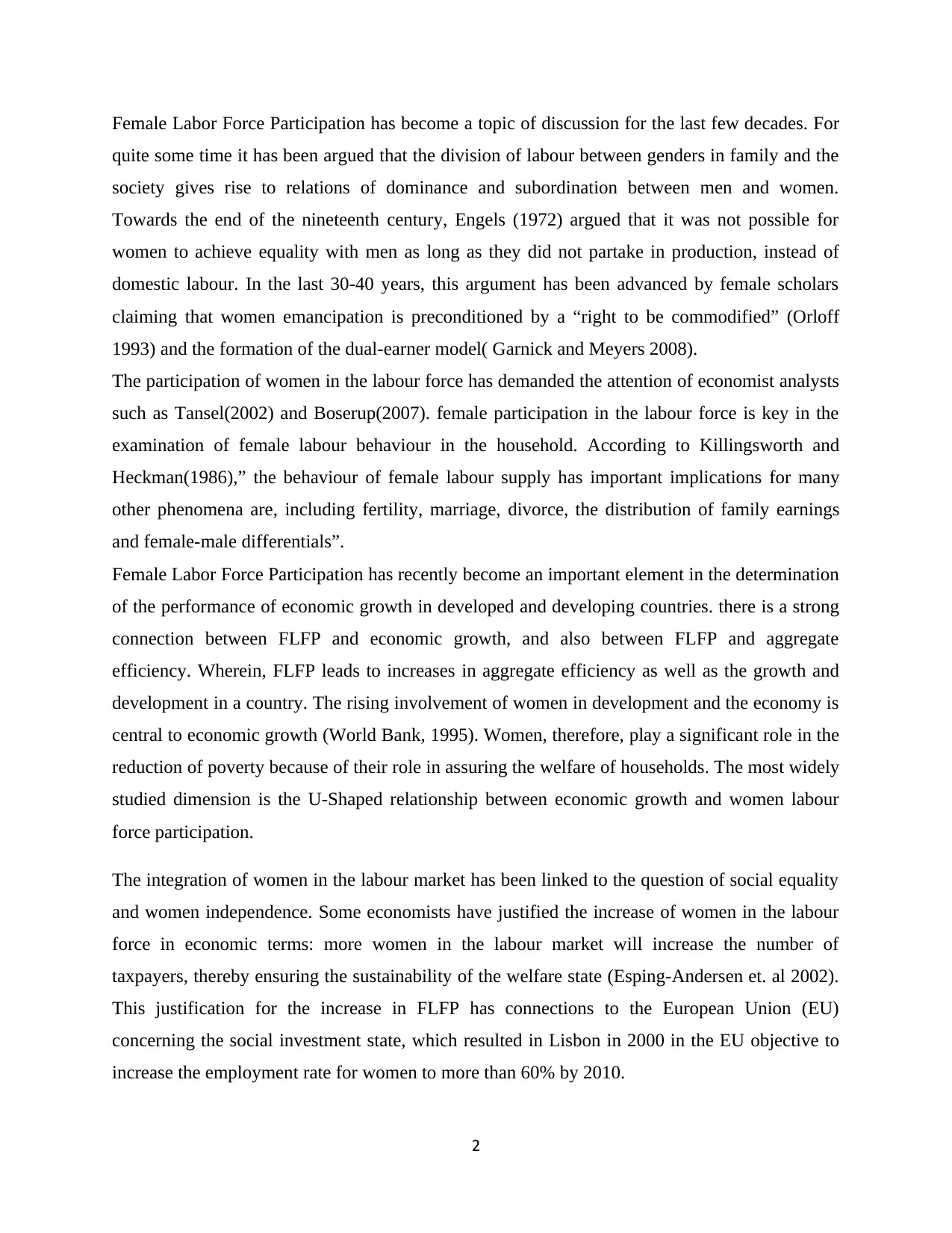
Female Labor Force Participation has become a topic of discussion for the last few decades. For
quite some time it has been argued that the division of labour between genders in family and the
society gives rise to relations of dominance and subordination between men and women.
Towards the end of the nineteenth century, Engels (1972) argued that it was not possible for
women to achieve equality with men as long as they did not partake in production, instead of
domestic labour. In the last 30-40 years, this argument has been advanced by female scholars
claiming that women emancipation is preconditioned by a “right to be commodified” (Orloff
1993) and the formation of the dual-earner model( Garnick and Meyers 2008).
The participation of women in the labour force has demanded the attention of economist analysts
such as Tansel(2002) and Boserup(2007). female participation in the labour force is key in the
examination of female labour behaviour in the household. According to Killingsworth and
Heckman(1986),” the behaviour of female labour supply has important implications for many
other phenomena are, including fertility, marriage, divorce, the distribution of family earnings
and female-male differentials”.
Female Labor Force Participation has recently become an important element in the determination
of the performance of economic growth in developed and developing countries. there is a strong
connection between FLFP and economic growth, and also between FLFP and aggregate
efficiency. Wherein, FLFP leads to increases in aggregate efficiency as well as the growth and
development in a country. The rising involvement of women in development and the economy is
central to economic growth (World Bank, 1995). Women, therefore, play a significant role in the
reduction of poverty because of their role in assuring the welfare of households. The most widely
studied dimension is the U-Shaped relationship between economic growth and women labour
force participation.
The integration of women in the labour market has been linked to the question of social equality
and women independence. Some economists have justified the increase of women in the labour
force in economic terms: more women in the labour market will increase the number of
taxpayers, thereby ensuring the sustainability of the welfare state (Esping-Andersen et. al 2002).
This justification for the increase in FLFP has connections to the European Union (EU)
concerning the social investment state, which resulted in Lisbon in 2000 in the EU objective to
increase the employment rate for women to more than 60% by 2010.
2
quite some time it has been argued that the division of labour between genders in family and the
society gives rise to relations of dominance and subordination between men and women.
Towards the end of the nineteenth century, Engels (1972) argued that it was not possible for
women to achieve equality with men as long as they did not partake in production, instead of
domestic labour. In the last 30-40 years, this argument has been advanced by female scholars
claiming that women emancipation is preconditioned by a “right to be commodified” (Orloff
1993) and the formation of the dual-earner model( Garnick and Meyers 2008).
The participation of women in the labour force has demanded the attention of economist analysts
such as Tansel(2002) and Boserup(2007). female participation in the labour force is key in the
examination of female labour behaviour in the household. According to Killingsworth and
Heckman(1986),” the behaviour of female labour supply has important implications for many
other phenomena are, including fertility, marriage, divorce, the distribution of family earnings
and female-male differentials”.
Female Labor Force Participation has recently become an important element in the determination
of the performance of economic growth in developed and developing countries. there is a strong
connection between FLFP and economic growth, and also between FLFP and aggregate
efficiency. Wherein, FLFP leads to increases in aggregate efficiency as well as the growth and
development in a country. The rising involvement of women in development and the economy is
central to economic growth (World Bank, 1995). Women, therefore, play a significant role in the
reduction of poverty because of their role in assuring the welfare of households. The most widely
studied dimension is the U-Shaped relationship between economic growth and women labour
force participation.
The integration of women in the labour market has been linked to the question of social equality
and women independence. Some economists have justified the increase of women in the labour
force in economic terms: more women in the labour market will increase the number of
taxpayers, thereby ensuring the sustainability of the welfare state (Esping-Andersen et. al 2002).
This justification for the increase in FLFP has connections to the European Union (EU)
concerning the social investment state, which resulted in Lisbon in 2000 in the EU objective to
increase the employment rate for women to more than 60% by 2010.
2
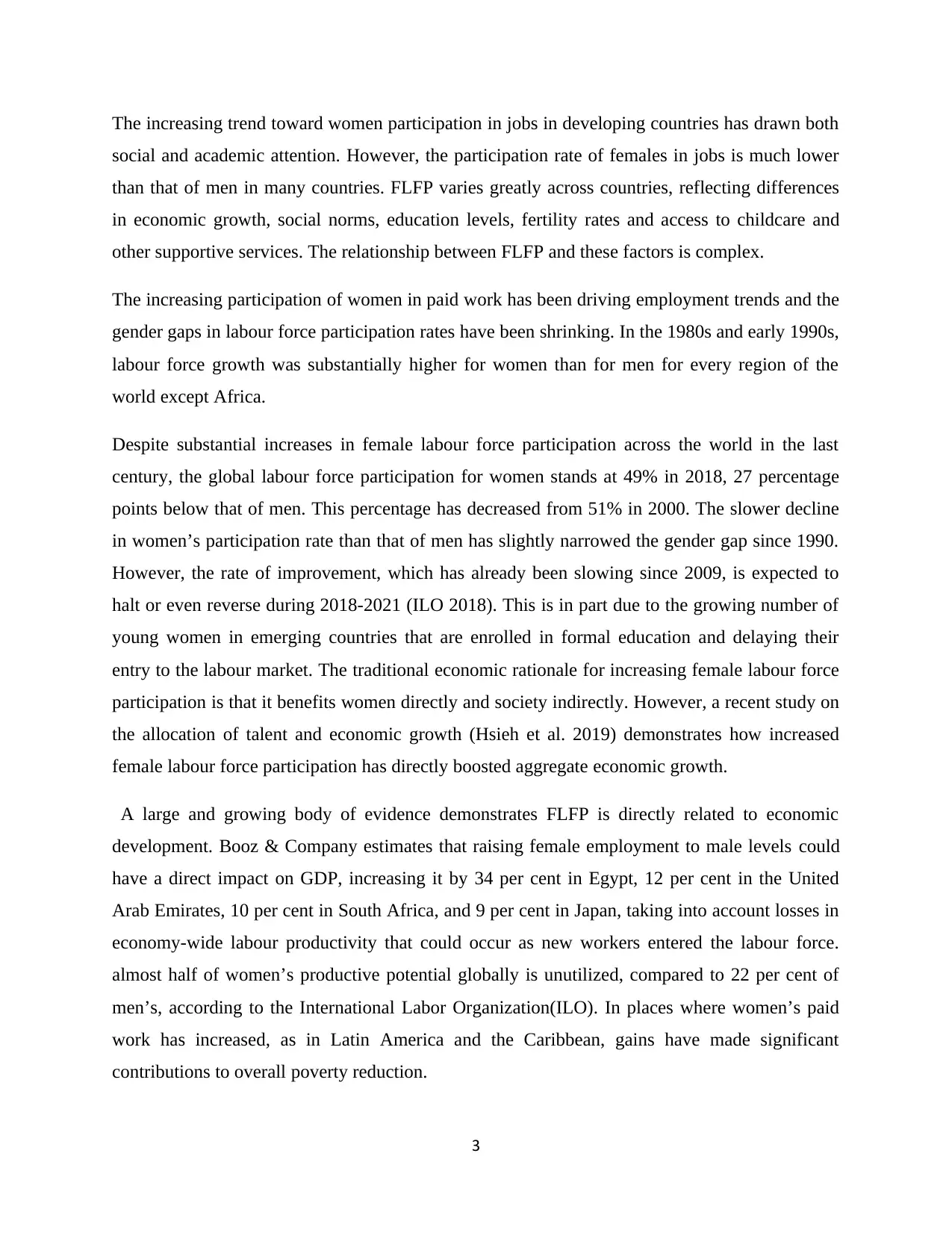
The increasing trend toward women participation in jobs in developing countries has drawn both
social and academic attention. However, the participation rate of females in jobs is much lower
than that of men in many countries. FLFP varies greatly across countries, reflecting differences
in economic growth, social norms, education levels, fertility rates and access to childcare and
other supportive services. The relationship between FLFP and these factors is complex.
The increasing participation of women in paid work has been driving employment trends and the
gender gaps in labour force participation rates have been shrinking. In the 1980s and early 1990s,
labour force growth was substantially higher for women than for men for every region of the
world except Africa.
Despite substantial increases in female labour force participation across the world in the last
century, the global labour force participation for women stands at 49% in 2018, 27 percentage
points below that of men. This percentage has decreased from 51% in 2000. The slower decline
in women’s participation rate than that of men has slightly narrowed the gender gap since 1990.
However, the rate of improvement, which has already been slowing since 2009, is expected to
halt or even reverse during 2018-2021 (ILO 2018). This is in part due to the growing number of
young women in emerging countries that are enrolled in formal education and delaying their
entry to the labour market. The traditional economic rationale for increasing female labour force
participation is that it benefits women directly and society indirectly. However, a recent study on
the allocation of talent and economic growth (Hsieh et al. 2019) demonstrates how increased
female labour force participation has directly boosted aggregate economic growth.
A large and growing body of evidence demonstrates FLFP is directly related to economic
development. Booz & Company estimates that raising female employment to male levels could
have a direct impact on GDP, increasing it by 34 per cent in Egypt, 12 per cent in the United
Arab Emirates, 10 per cent in South Africa, and 9 per cent in Japan, taking into account losses in
economy-wide labour productivity that could occur as new workers entered the labour force.
almost half of women’s productive potential globally is unutilized, compared to 22 per cent of
men’s, according to the International Labor Organization(ILO). In places where women’s paid
work has increased, as in Latin America and the Caribbean, gains have made significant
contributions to overall poverty reduction.
3
social and academic attention. However, the participation rate of females in jobs is much lower
than that of men in many countries. FLFP varies greatly across countries, reflecting differences
in economic growth, social norms, education levels, fertility rates and access to childcare and
other supportive services. The relationship between FLFP and these factors is complex.
The increasing participation of women in paid work has been driving employment trends and the
gender gaps in labour force participation rates have been shrinking. In the 1980s and early 1990s,
labour force growth was substantially higher for women than for men for every region of the
world except Africa.
Despite substantial increases in female labour force participation across the world in the last
century, the global labour force participation for women stands at 49% in 2018, 27 percentage
points below that of men. This percentage has decreased from 51% in 2000. The slower decline
in women’s participation rate than that of men has slightly narrowed the gender gap since 1990.
However, the rate of improvement, which has already been slowing since 2009, is expected to
halt or even reverse during 2018-2021 (ILO 2018). This is in part due to the growing number of
young women in emerging countries that are enrolled in formal education and delaying their
entry to the labour market. The traditional economic rationale for increasing female labour force
participation is that it benefits women directly and society indirectly. However, a recent study on
the allocation of talent and economic growth (Hsieh et al. 2019) demonstrates how increased
female labour force participation has directly boosted aggregate economic growth.
A large and growing body of evidence demonstrates FLFP is directly related to economic
development. Booz & Company estimates that raising female employment to male levels could
have a direct impact on GDP, increasing it by 34 per cent in Egypt, 12 per cent in the United
Arab Emirates, 10 per cent in South Africa, and 9 per cent in Japan, taking into account losses in
economy-wide labour productivity that could occur as new workers entered the labour force.
almost half of women’s productive potential globally is unutilized, compared to 22 per cent of
men’s, according to the International Labor Organization(ILO). In places where women’s paid
work has increased, as in Latin America and the Caribbean, gains have made significant
contributions to overall poverty reduction.
3
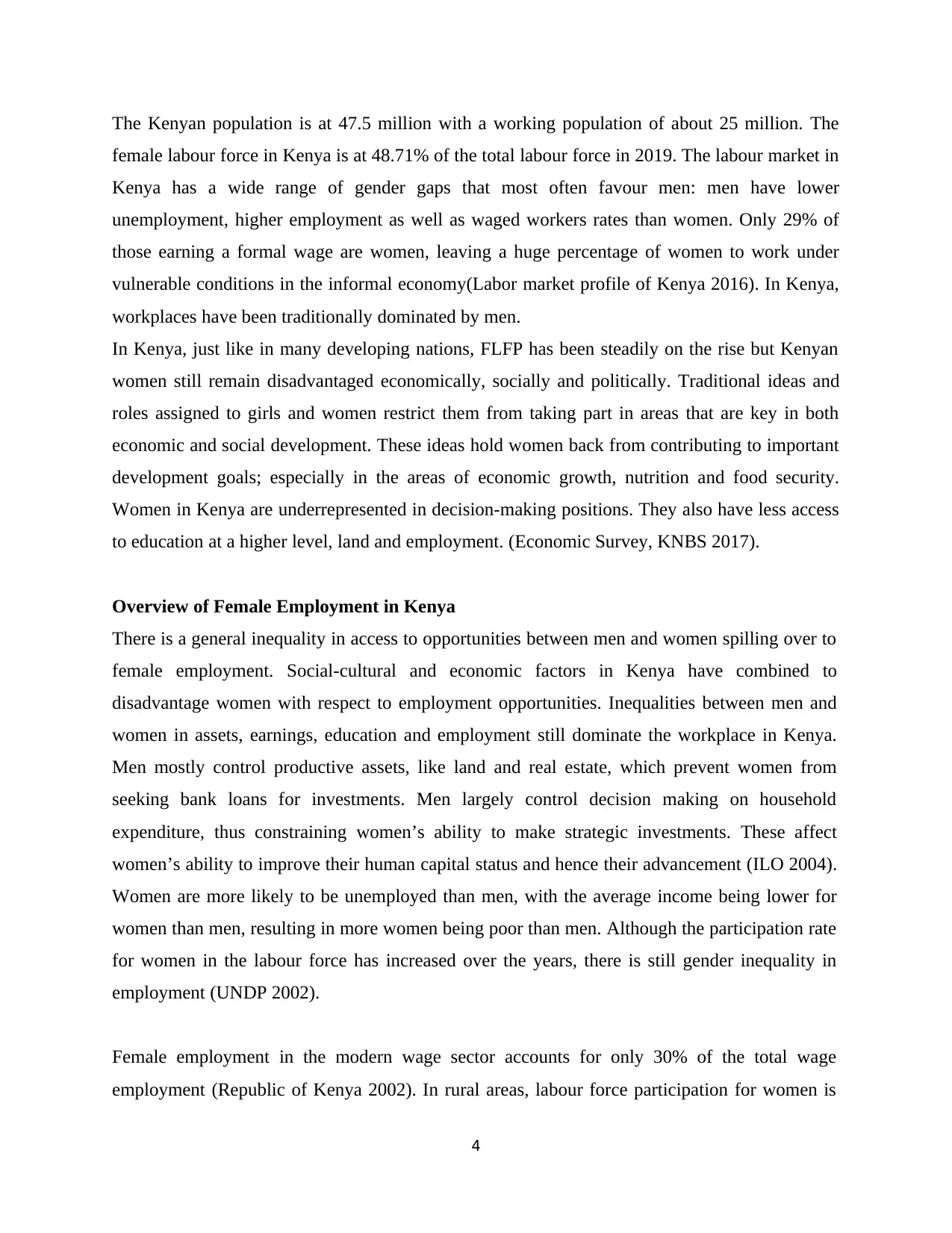
The Kenyan population is at 47.5 million with a working population of about 25 million. The
female labour force in Kenya is at 48.71% of the total labour force in 2019. The labour market in
Kenya has a wide range of gender gaps that most often favour men: men have lower
unemployment, higher employment as well as waged workers rates than women. Only 29% of
those earning a formal wage are women, leaving a huge percentage of women to work under
vulnerable conditions in the informal economy(Labor market profile of Kenya 2016). In Kenya,
workplaces have been traditionally dominated by men.
In Kenya, just like in many developing nations, FLFP has been steadily on the rise but Kenyan
women still remain disadvantaged economically, socially and politically. Traditional ideas and
roles assigned to girls and women restrict them from taking part in areas that are key in both
economic and social development. These ideas hold women back from contributing to important
development goals; especially in the areas of economic growth, nutrition and food security.
Women in Kenya are underrepresented in decision-making positions. They also have less access
to education at a higher level, land and employment. (Economic Survey, KNBS 2017).
Overview of Female Employment in Kenya
There is a general inequality in access to opportunities between men and women spilling over to
female employment. Social-cultural and economic factors in Kenya have combined to
disadvantage women with respect to employment opportunities. Inequalities between men and
women in assets, earnings, education and employment still dominate the workplace in Kenya.
Men mostly control productive assets, like land and real estate, which prevent women from
seeking bank loans for investments. Men largely control decision making on household
expenditure, thus constraining women’s ability to make strategic investments. These affect
women’s ability to improve their human capital status and hence their advancement (ILO 2004).
Women are more likely to be unemployed than men, with the average income being lower for
women than men, resulting in more women being poor than men. Although the participation rate
for women in the labour force has increased over the years, there is still gender inequality in
employment (UNDP 2002).
Female employment in the modern wage sector accounts for only 30% of the total wage
employment (Republic of Kenya 2002). In rural areas, labour force participation for women is
4
female labour force in Kenya is at 48.71% of the total labour force in 2019. The labour market in
Kenya has a wide range of gender gaps that most often favour men: men have lower
unemployment, higher employment as well as waged workers rates than women. Only 29% of
those earning a formal wage are women, leaving a huge percentage of women to work under
vulnerable conditions in the informal economy(Labor market profile of Kenya 2016). In Kenya,
workplaces have been traditionally dominated by men.
In Kenya, just like in many developing nations, FLFP has been steadily on the rise but Kenyan
women still remain disadvantaged economically, socially and politically. Traditional ideas and
roles assigned to girls and women restrict them from taking part in areas that are key in both
economic and social development. These ideas hold women back from contributing to important
development goals; especially in the areas of economic growth, nutrition and food security.
Women in Kenya are underrepresented in decision-making positions. They also have less access
to education at a higher level, land and employment. (Economic Survey, KNBS 2017).
Overview of Female Employment in Kenya
There is a general inequality in access to opportunities between men and women spilling over to
female employment. Social-cultural and economic factors in Kenya have combined to
disadvantage women with respect to employment opportunities. Inequalities between men and
women in assets, earnings, education and employment still dominate the workplace in Kenya.
Men mostly control productive assets, like land and real estate, which prevent women from
seeking bank loans for investments. Men largely control decision making on household
expenditure, thus constraining women’s ability to make strategic investments. These affect
women’s ability to improve their human capital status and hence their advancement (ILO 2004).
Women are more likely to be unemployed than men, with the average income being lower for
women than men, resulting in more women being poor than men. Although the participation rate
for women in the labour force has increased over the years, there is still gender inequality in
employment (UNDP 2002).
Female employment in the modern wage sector accounts for only 30% of the total wage
employment (Republic of Kenya 2002). In rural areas, labour force participation for women is
4
Secure Best Marks with AI Grader
Need help grading? Try our AI Grader for instant feedback on your assignments.
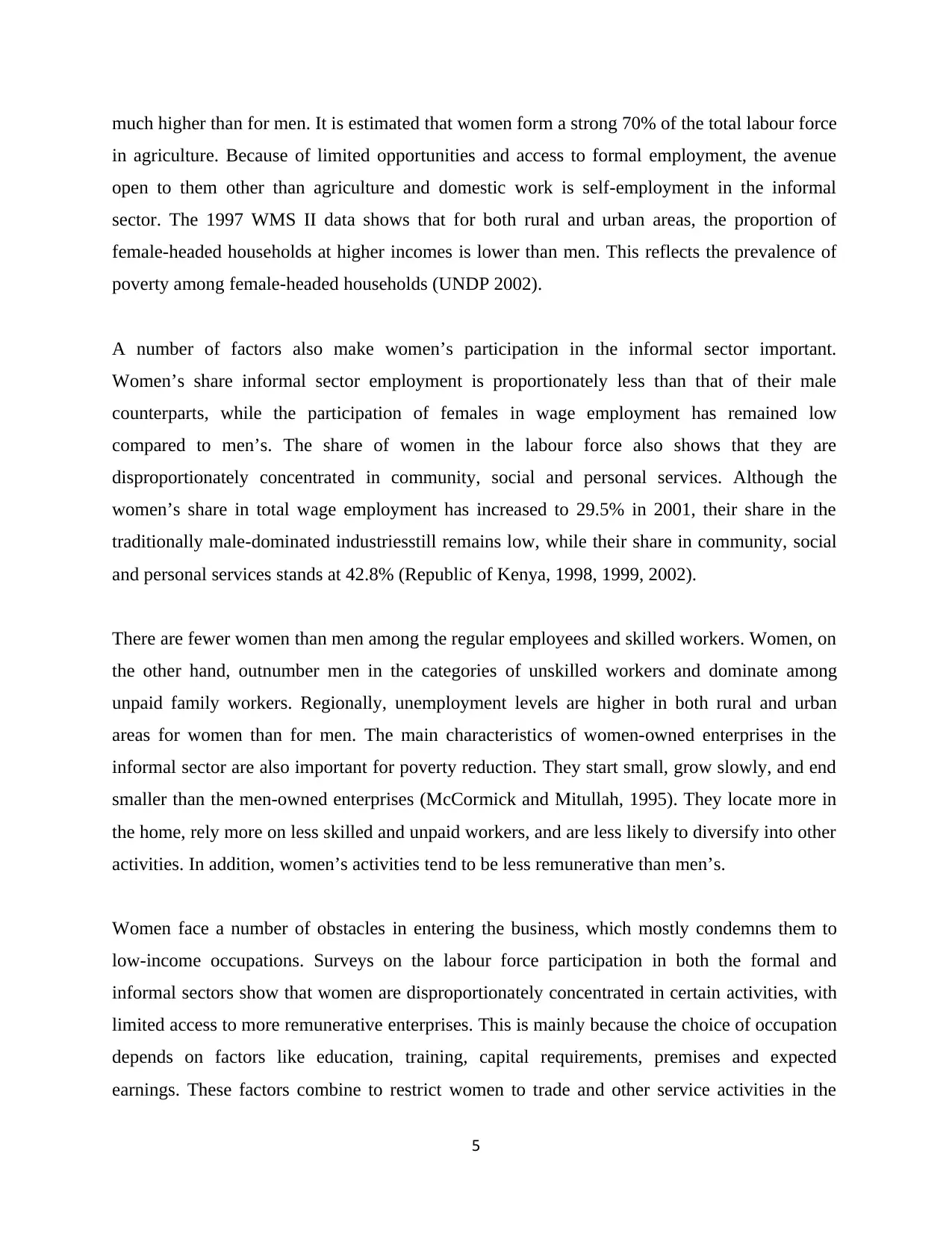
much higher than for men. It is estimated that women form a strong 70% of the total labour force
in agriculture. Because of limited opportunities and access to formal employment, the avenue
open to them other than agriculture and domestic work is self-employment in the informal
sector. The 1997 WMS II data shows that for both rural and urban areas, the proportion of
female-headed households at higher incomes is lower than men. This reflects the prevalence of
poverty among female-headed households (UNDP 2002).
A number of factors also make women’s participation in the informal sector important.
Women’s share informal sector employment is proportionately less than that of their male
counterparts, while the participation of females in wage employment has remained low
compared to men’s. The share of women in the labour force also shows that they are
disproportionately concentrated in community, social and personal services. Although the
women’s share in total wage employment has increased to 29.5% in 2001, their share in the
traditionally male-dominated industriesstill remains low, while their share in community, social
and personal services stands at 42.8% (Republic of Kenya, 1998, 1999, 2002).
There are fewer women than men among the regular employees and skilled workers. Women, on
the other hand, outnumber men in the categories of unskilled workers and dominate among
unpaid family workers. Regionally, unemployment levels are higher in both rural and urban
areas for women than for men. The main characteristics of women-owned enterprises in the
informal sector are also important for poverty reduction. They start small, grow slowly, and end
smaller than the men-owned enterprises (McCormick and Mitullah, 1995). They locate more in
the home, rely more on less skilled and unpaid workers, and are less likely to diversify into other
activities. In addition, women’s activities tend to be less remunerative than men’s.
Women face a number of obstacles in entering the business, which mostly condemns them to
low-income occupations. Surveys on the labour force participation in both the formal and
informal sectors show that women are disproportionately concentrated in certain activities, with
limited access to more remunerative enterprises. This is mainly because the choice of occupation
depends on factors like education, training, capital requirements, premises and expected
earnings. These factors combine to restrict women to trade and other service activities in the
5
in agriculture. Because of limited opportunities and access to formal employment, the avenue
open to them other than agriculture and domestic work is self-employment in the informal
sector. The 1997 WMS II data shows that for both rural and urban areas, the proportion of
female-headed households at higher incomes is lower than men. This reflects the prevalence of
poverty among female-headed households (UNDP 2002).
A number of factors also make women’s participation in the informal sector important.
Women’s share informal sector employment is proportionately less than that of their male
counterparts, while the participation of females in wage employment has remained low
compared to men’s. The share of women in the labour force also shows that they are
disproportionately concentrated in community, social and personal services. Although the
women’s share in total wage employment has increased to 29.5% in 2001, their share in the
traditionally male-dominated industriesstill remains low, while their share in community, social
and personal services stands at 42.8% (Republic of Kenya, 1998, 1999, 2002).
There are fewer women than men among the regular employees and skilled workers. Women, on
the other hand, outnumber men in the categories of unskilled workers and dominate among
unpaid family workers. Regionally, unemployment levels are higher in both rural and urban
areas for women than for men. The main characteristics of women-owned enterprises in the
informal sector are also important for poverty reduction. They start small, grow slowly, and end
smaller than the men-owned enterprises (McCormick and Mitullah, 1995). They locate more in
the home, rely more on less skilled and unpaid workers, and are less likely to diversify into other
activities. In addition, women’s activities tend to be less remunerative than men’s.
Women face a number of obstacles in entering the business, which mostly condemns them to
low-income occupations. Surveys on the labour force participation in both the formal and
informal sectors show that women are disproportionately concentrated in certain activities, with
limited access to more remunerative enterprises. This is mainly because the choice of occupation
depends on factors like education, training, capital requirements, premises and expected
earnings. These factors combine to restrict women to trade and other service activities in the
5
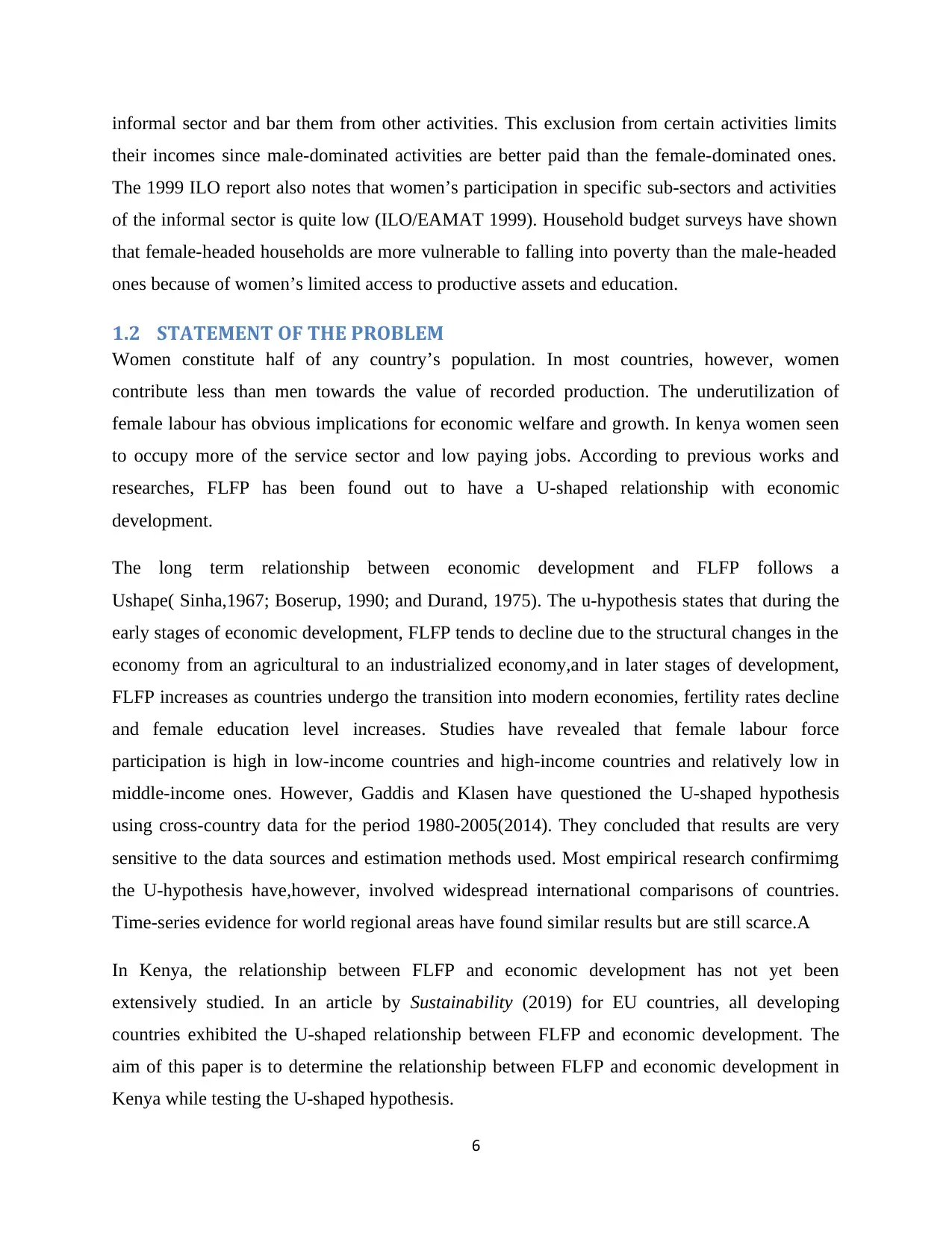
informal sector and bar them from other activities. This exclusion from certain activities limits
their incomes since male-dominated activities are better paid than the female-dominated ones.
The 1999 ILO report also notes that women’s participation in specific sub-sectors and activities
of the informal sector is quite low (ILO/EAMAT 1999). Household budget surveys have shown
that female-headed households are more vulnerable to falling into poverty than the male-headed
ones because of women’s limited access to productive assets and education.
1.2 STATEMENT OF THE PROBLEM
Women constitute half of any country’s population. In most countries, however, women
contribute less than men towards the value of recorded production. The underutilization of
female labour has obvious implications for economic welfare and growth. In kenya women seen
to occupy more of the service sector and low paying jobs. According to previous works and
researches, FLFP has been found out to have a U-shaped relationship with economic
development.
The long term relationship between economic development and FLFP follows a
Ushape( Sinha,1967; Boserup, 1990; and Durand, 1975). The u-hypothesis states that during the
early stages of economic development, FLFP tends to decline due to the structural changes in the
economy from an agricultural to an industrialized economy,and in later stages of development,
FLFP increases as countries undergo the transition into modern economies, fertility rates decline
and female education level increases. Studies have revealed that female labour force
participation is high in low-income countries and high-income countries and relatively low in
middle-income ones. However, Gaddis and Klasen have questioned the U-shaped hypothesis
using cross-country data for the period 1980-2005(2014). They concluded that results are very
sensitive to the data sources and estimation methods used. Most empirical research confirmimg
the U-hypothesis have,however, involved widespread international comparisons of countries.
Time-series evidence for world regional areas have found similar results but are still scarce.A
In Kenya, the relationship between FLFP and economic development has not yet been
extensively studied. In an article by Sustainability (2019) for EU countries, all developing
countries exhibited the U-shaped relationship between FLFP and economic development. The
aim of this paper is to determine the relationship between FLFP and economic development in
Kenya while testing the U-shaped hypothesis.
6
their incomes since male-dominated activities are better paid than the female-dominated ones.
The 1999 ILO report also notes that women’s participation in specific sub-sectors and activities
of the informal sector is quite low (ILO/EAMAT 1999). Household budget surveys have shown
that female-headed households are more vulnerable to falling into poverty than the male-headed
ones because of women’s limited access to productive assets and education.
1.2 STATEMENT OF THE PROBLEM
Women constitute half of any country’s population. In most countries, however, women
contribute less than men towards the value of recorded production. The underutilization of
female labour has obvious implications for economic welfare and growth. In kenya women seen
to occupy more of the service sector and low paying jobs. According to previous works and
researches, FLFP has been found out to have a U-shaped relationship with economic
development.
The long term relationship between economic development and FLFP follows a
Ushape( Sinha,1967; Boserup, 1990; and Durand, 1975). The u-hypothesis states that during the
early stages of economic development, FLFP tends to decline due to the structural changes in the
economy from an agricultural to an industrialized economy,and in later stages of development,
FLFP increases as countries undergo the transition into modern economies, fertility rates decline
and female education level increases. Studies have revealed that female labour force
participation is high in low-income countries and high-income countries and relatively low in
middle-income ones. However, Gaddis and Klasen have questioned the U-shaped hypothesis
using cross-country data for the period 1980-2005(2014). They concluded that results are very
sensitive to the data sources and estimation methods used. Most empirical research confirmimg
the U-hypothesis have,however, involved widespread international comparisons of countries.
Time-series evidence for world regional areas have found similar results but are still scarce.A
In Kenya, the relationship between FLFP and economic development has not yet been
extensively studied. In an article by Sustainability (2019) for EU countries, all developing
countries exhibited the U-shaped relationship between FLFP and economic development. The
aim of this paper is to determine the relationship between FLFP and economic development in
Kenya while testing the U-shaped hypothesis.
6
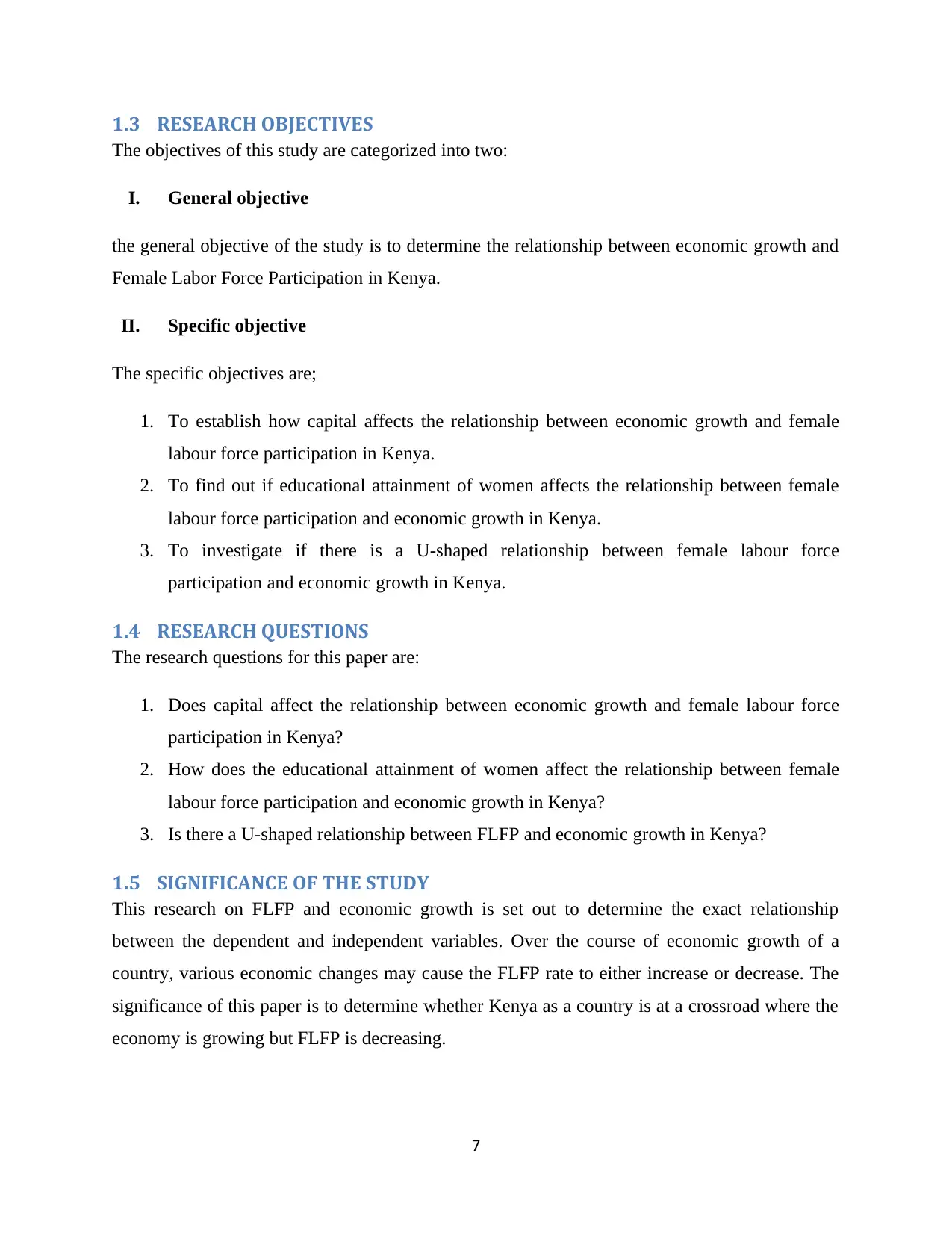
1.3 RESEARCH OBJECTIVES
The objectives of this study are categorized into two:
I. General objective
the general objective of the study is to determine the relationship between economic growth and
Female Labor Force Participation in Kenya.
II. Specific objective
The specific objectives are;
1. To establish how capital affects the relationship between economic growth and female
labour force participation in Kenya.
2. To find out if educational attainment of women affects the relationship between female
labour force participation and economic growth in Kenya.
3. To investigate if there is a U-shaped relationship between female labour force
participation and economic growth in Kenya.
1.4 RESEARCH QUESTIONS
The research questions for this paper are:
1. Does capital affect the relationship between economic growth and female labour force
participation in Kenya?
2. How does the educational attainment of women affect the relationship between female
labour force participation and economic growth in Kenya?
3. Is there a U-shaped relationship between FLFP and economic growth in Kenya?
1.5 SIGNIFICANCE OF THE STUDY
This research on FLFP and economic growth is set out to determine the exact relationship
between the dependent and independent variables. Over the course of economic growth of a
country, various economic changes may cause the FLFP rate to either increase or decrease. The
significance of this paper is to determine whether Kenya as a country is at a crossroad where the
economy is growing but FLFP is decreasing.
7
The objectives of this study are categorized into two:
I. General objective
the general objective of the study is to determine the relationship between economic growth and
Female Labor Force Participation in Kenya.
II. Specific objective
The specific objectives are;
1. To establish how capital affects the relationship between economic growth and female
labour force participation in Kenya.
2. To find out if educational attainment of women affects the relationship between female
labour force participation and economic growth in Kenya.
3. To investigate if there is a U-shaped relationship between female labour force
participation and economic growth in Kenya.
1.4 RESEARCH QUESTIONS
The research questions for this paper are:
1. Does capital affect the relationship between economic growth and female labour force
participation in Kenya?
2. How does the educational attainment of women affect the relationship between female
labour force participation and economic growth in Kenya?
3. Is there a U-shaped relationship between FLFP and economic growth in Kenya?
1.5 SIGNIFICANCE OF THE STUDY
This research on FLFP and economic growth is set out to determine the exact relationship
between the dependent and independent variables. Over the course of economic growth of a
country, various economic changes may cause the FLFP rate to either increase or decrease. The
significance of this paper is to determine whether Kenya as a country is at a crossroad where the
economy is growing but FLFP is decreasing.
7
Paraphrase This Document
Need a fresh take? Get an instant paraphrase of this document with our AI Paraphraser
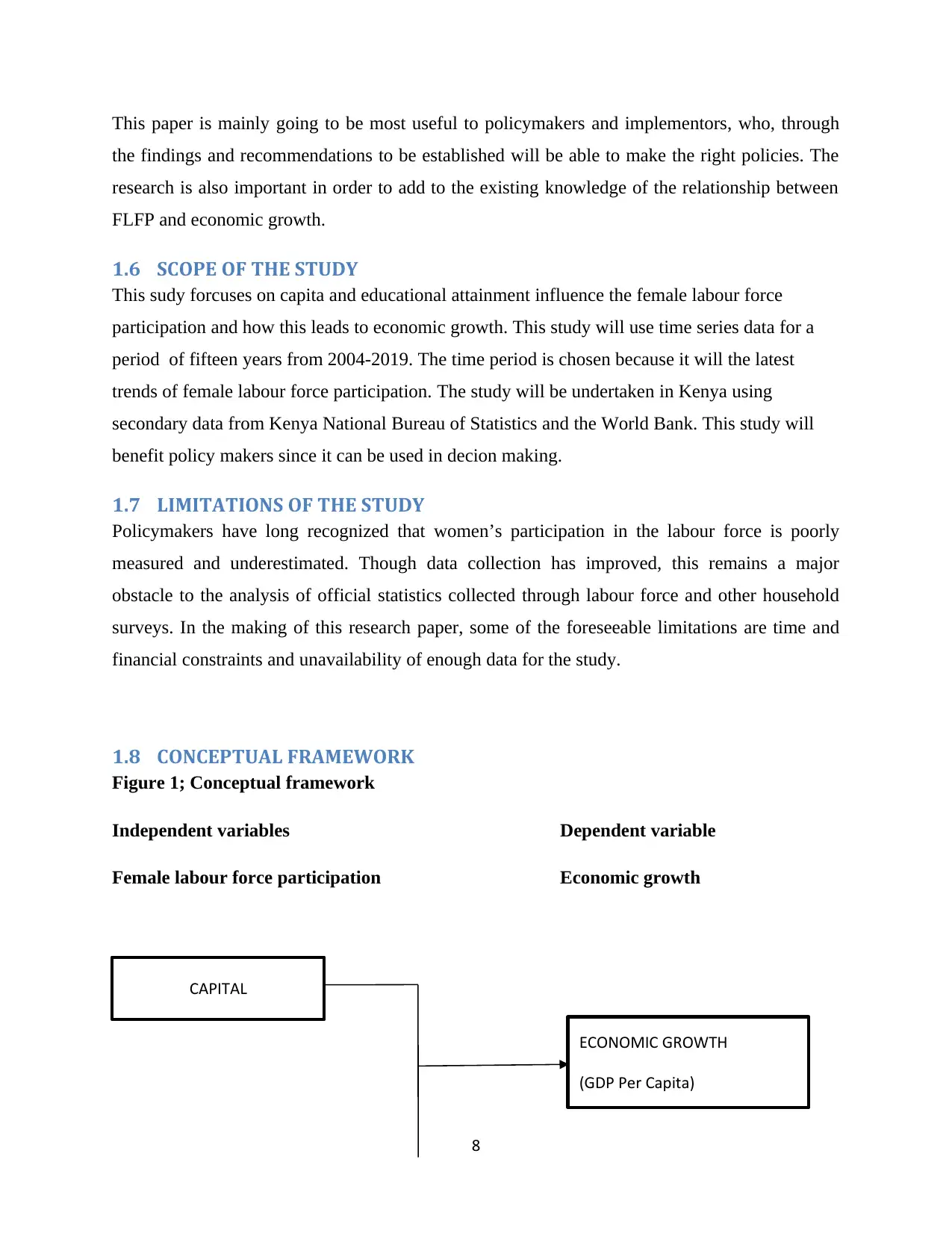
This paper is mainly going to be most useful to policymakers and implementors, who, through
the findings and recommendations to be established will be able to make the right policies. The
research is also important in order to add to the existing knowledge of the relationship between
FLFP and economic growth.
1.6 SCOPE OF THE STUDY
This sudy forcuses on capita and educational attainment influence the female labour force
participation and how this leads to economic growth. This study will use time series data for a
period of fifteen years from 2004-2019. The time period is chosen because it will the latest
trends of female labour force participation. The study will be undertaken in Kenya using
secondary data from Kenya National Bureau of Statistics and the World Bank. This study will
benefit policy makers since it can be used in decion making.
1.7 LIMITATIONS OF THE STUDY
Policymakers have long recognized that women’s participation in the labour force is poorly
measured and underestimated. Though data collection has improved, this remains a major
obstacle to the analysis of official statistics collected through labour force and other household
surveys. In the making of this research paper, some of the foreseeable limitations are time and
financial constraints and unavailability of enough data for the study.
1.8 CONCEPTUAL FRAMEWORK
Figure 1; Conceptual framework
Independent variables Dependent variable
Female labour force participation Economic growth
8
ECONOMIC GROWTH
(GDP Per Capita)
CAPITAL
the findings and recommendations to be established will be able to make the right policies. The
research is also important in order to add to the existing knowledge of the relationship between
FLFP and economic growth.
1.6 SCOPE OF THE STUDY
This sudy forcuses on capita and educational attainment influence the female labour force
participation and how this leads to economic growth. This study will use time series data for a
period of fifteen years from 2004-2019. The time period is chosen because it will the latest
trends of female labour force participation. The study will be undertaken in Kenya using
secondary data from Kenya National Bureau of Statistics and the World Bank. This study will
benefit policy makers since it can be used in decion making.
1.7 LIMITATIONS OF THE STUDY
Policymakers have long recognized that women’s participation in the labour force is poorly
measured and underestimated. Though data collection has improved, this remains a major
obstacle to the analysis of official statistics collected through labour force and other household
surveys. In the making of this research paper, some of the foreseeable limitations are time and
financial constraints and unavailability of enough data for the study.
1.8 CONCEPTUAL FRAMEWORK
Figure 1; Conceptual framework
Independent variables Dependent variable
Female labour force participation Economic growth
8
ECONOMIC GROWTH
(GDP Per Capita)
CAPITAL
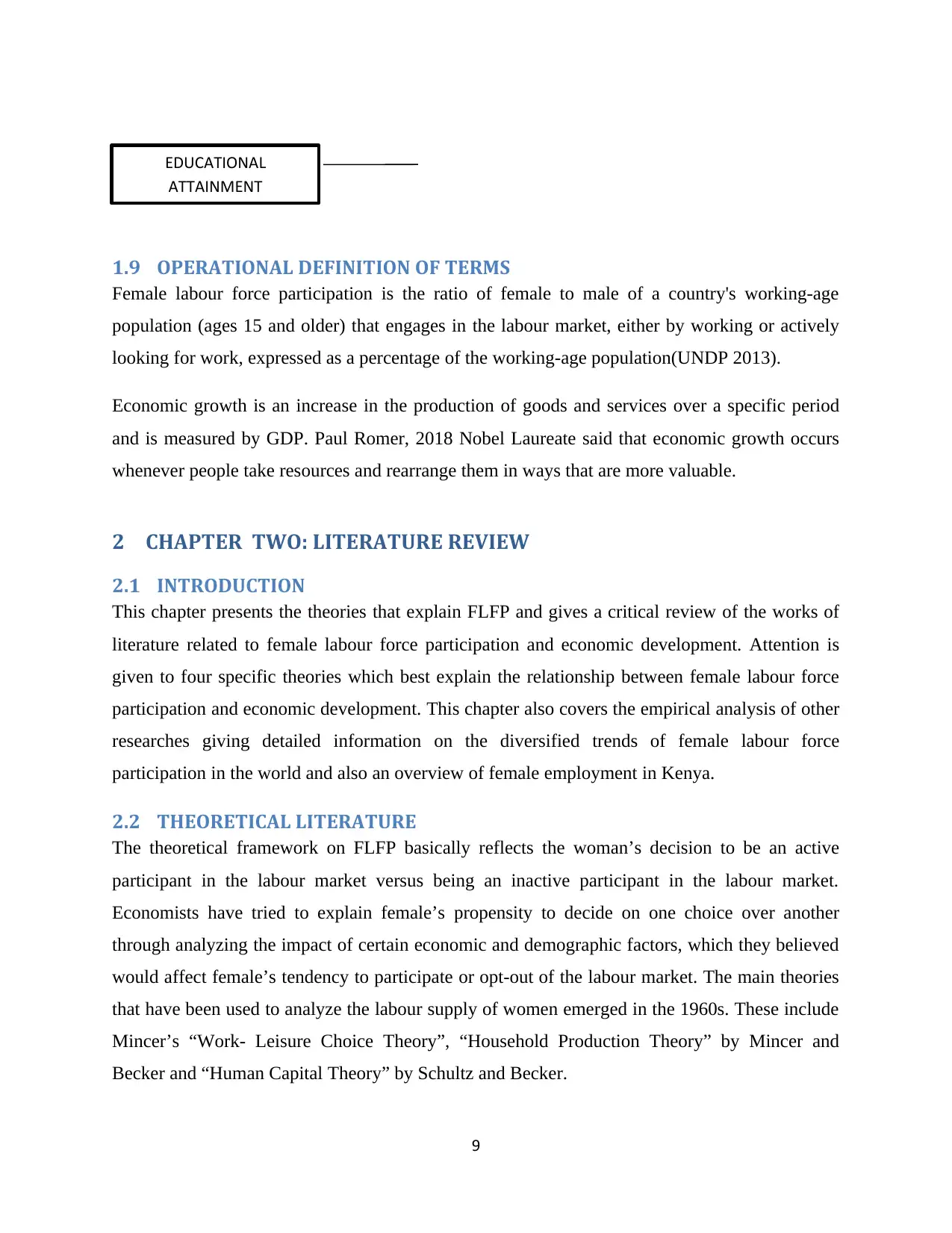
1.9 OPERATIONAL DEFINITION OF TERMS
Female labour force participation is the ratio of female to male of a country's working-age
population (ages 15 and older) that engages in the labour market, either by working or actively
looking for work, expressed as a percentage of the working-age population(UNDP 2013).
Economic growth is an increase in the production of goods and services over a specific period
and is measured by GDP. Paul Romer, 2018 Nobel Laureate said that economic growth occurs
whenever people take resources and rearrange them in ways that are more valuable.
2 CHAPTER TWO: LITERATURE REVIEW
2.1 INTRODUCTION
This chapter presents the theories that explain FLFP and gives a critical review of the works of
literature related to female labour force participation and economic development. Attention is
given to four specific theories which best explain the relationship between female labour force
participation and economic development. This chapter also covers the empirical analysis of other
researches giving detailed information on the diversified trends of female labour force
participation in the world and also an overview of female employment in Kenya.
2.2 THEORETICAL LITERATURE
The theoretical framework on FLFP basically reflects the woman’s decision to be an active
participant in the labour market versus being an inactive participant in the labour market.
Economists have tried to explain female’s propensity to decide on one choice over another
through analyzing the impact of certain economic and demographic factors, which they believed
would affect female’s tendency to participate or opt-out of the labour market. The main theories
that have been used to analyze the labour supply of women emerged in the 1960s. These include
Mincer’s “Work- Leisure Choice Theory”, “Household Production Theory” by Mincer and
Becker and “Human Capital Theory” by Schultz and Becker.
9
EDUCATIONAL
ATTAINMENT
Female labour force participation is the ratio of female to male of a country's working-age
population (ages 15 and older) that engages in the labour market, either by working or actively
looking for work, expressed as a percentage of the working-age population(UNDP 2013).
Economic growth is an increase in the production of goods and services over a specific period
and is measured by GDP. Paul Romer, 2018 Nobel Laureate said that economic growth occurs
whenever people take resources and rearrange them in ways that are more valuable.
2 CHAPTER TWO: LITERATURE REVIEW
2.1 INTRODUCTION
This chapter presents the theories that explain FLFP and gives a critical review of the works of
literature related to female labour force participation and economic development. Attention is
given to four specific theories which best explain the relationship between female labour force
participation and economic development. This chapter also covers the empirical analysis of other
researches giving detailed information on the diversified trends of female labour force
participation in the world and also an overview of female employment in Kenya.
2.2 THEORETICAL LITERATURE
The theoretical framework on FLFP basically reflects the woman’s decision to be an active
participant in the labour market versus being an inactive participant in the labour market.
Economists have tried to explain female’s propensity to decide on one choice over another
through analyzing the impact of certain economic and demographic factors, which they believed
would affect female’s tendency to participate or opt-out of the labour market. The main theories
that have been used to analyze the labour supply of women emerged in the 1960s. These include
Mincer’s “Work- Leisure Choice Theory”, “Household Production Theory” by Mincer and
Becker and “Human Capital Theory” by Schultz and Becker.
9
EDUCATIONAL
ATTAINMENT
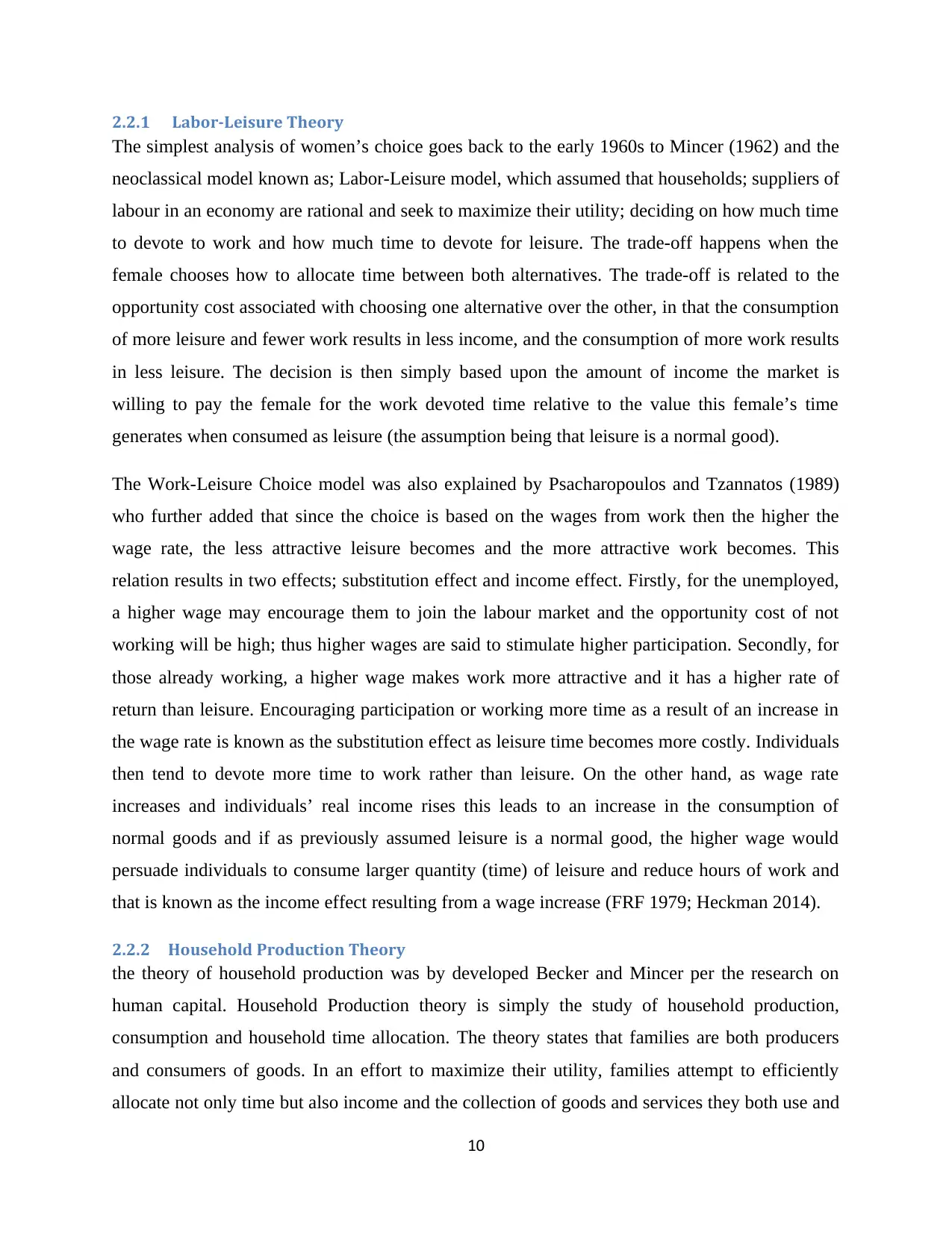
2.2.1 Labor-Leisure Theory
The simplest analysis of women’s choice goes back to the early 1960s to Mincer (1962) and the
neoclassical model known as; Labor-Leisure model, which assumed that households; suppliers of
labour in an economy are rational and seek to maximize their utility; deciding on how much time
to devote to work and how much time to devote for leisure. The trade-off happens when the
female chooses how to allocate time between both alternatives. The trade-off is related to the
opportunity cost associated with choosing one alternative over the other, in that the consumption
of more leisure and fewer work results in less income, and the consumption of more work results
in less leisure. The decision is then simply based upon the amount of income the market is
willing to pay the female for the work devoted time relative to the value this female’s time
generates when consumed as leisure (the assumption being that leisure is a normal good).
The Work-Leisure Choice model was also explained by Psacharopoulos and Tzannatos (1989)
who further added that since the choice is based on the wages from work then the higher the
wage rate, the less attractive leisure becomes and the more attractive work becomes. This
relation results in two effects; substitution effect and income effect. Firstly, for the unemployed,
a higher wage may encourage them to join the labour market and the opportunity cost of not
working will be high; thus higher wages are said to stimulate higher participation. Secondly, for
those already working, a higher wage makes work more attractive and it has a higher rate of
return than leisure. Encouraging participation or working more time as a result of an increase in
the wage rate is known as the substitution effect as leisure time becomes more costly. Individuals
then tend to devote more time to work rather than leisure. On the other hand, as wage rate
increases and individuals’ real income rises this leads to an increase in the consumption of
normal goods and if as previously assumed leisure is a normal good, the higher wage would
persuade individuals to consume larger quantity (time) of leisure and reduce hours of work and
that is known as the income effect resulting from a wage increase (FRF 1979; Heckman 2014).
2.2.2 Household Production Theory
the theory of household production was by developed Becker and Mincer per the research on
human capital. Household Production theory is simply the study of household production,
consumption and household time allocation. The theory states that families are both producers
and consumers of goods. In an effort to maximize their utility, families attempt to efficiently
allocate not only time but also income and the collection of goods and services they both use and
10
The simplest analysis of women’s choice goes back to the early 1960s to Mincer (1962) and the
neoclassical model known as; Labor-Leisure model, which assumed that households; suppliers of
labour in an economy are rational and seek to maximize their utility; deciding on how much time
to devote to work and how much time to devote for leisure. The trade-off happens when the
female chooses how to allocate time between both alternatives. The trade-off is related to the
opportunity cost associated with choosing one alternative over the other, in that the consumption
of more leisure and fewer work results in less income, and the consumption of more work results
in less leisure. The decision is then simply based upon the amount of income the market is
willing to pay the female for the work devoted time relative to the value this female’s time
generates when consumed as leisure (the assumption being that leisure is a normal good).
The Work-Leisure Choice model was also explained by Psacharopoulos and Tzannatos (1989)
who further added that since the choice is based on the wages from work then the higher the
wage rate, the less attractive leisure becomes and the more attractive work becomes. This
relation results in two effects; substitution effect and income effect. Firstly, for the unemployed,
a higher wage may encourage them to join the labour market and the opportunity cost of not
working will be high; thus higher wages are said to stimulate higher participation. Secondly, for
those already working, a higher wage makes work more attractive and it has a higher rate of
return than leisure. Encouraging participation or working more time as a result of an increase in
the wage rate is known as the substitution effect as leisure time becomes more costly. Individuals
then tend to devote more time to work rather than leisure. On the other hand, as wage rate
increases and individuals’ real income rises this leads to an increase in the consumption of
normal goods and if as previously assumed leisure is a normal good, the higher wage would
persuade individuals to consume larger quantity (time) of leisure and reduce hours of work and
that is known as the income effect resulting from a wage increase (FRF 1979; Heckman 2014).
2.2.2 Household Production Theory
the theory of household production was by developed Becker and Mincer per the research on
human capital. Household Production theory is simply the study of household production,
consumption and household time allocation. The theory states that families are both producers
and consumers of goods. In an effort to maximize their utility, families attempt to efficiently
allocate not only time but also income and the collection of goods and services they both use and
10
Secure Best Marks with AI Grader
Need help grading? Try our AI Grader for instant feedback on your assignments.
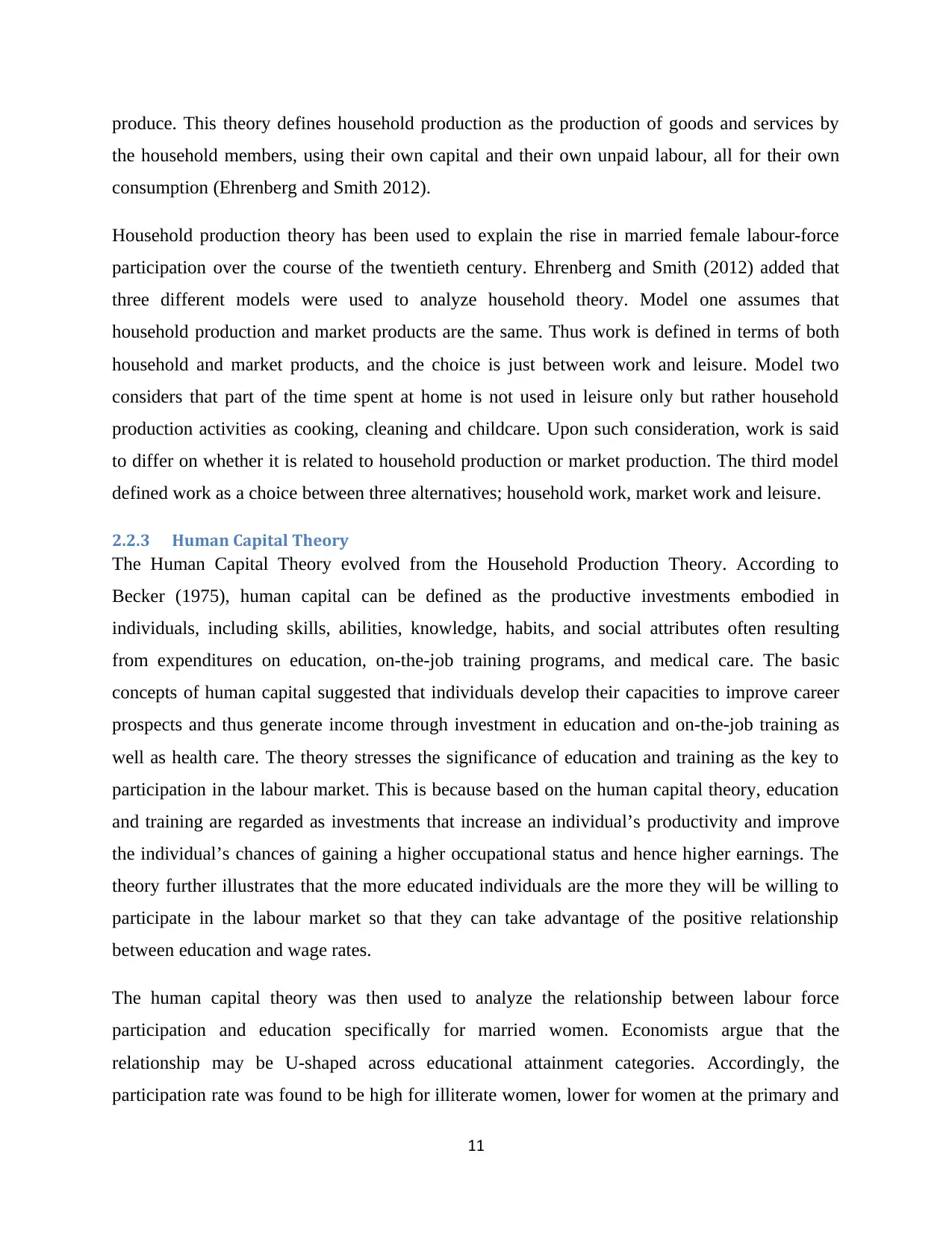
produce. This theory defines household production as the production of goods and services by
the household members, using their own capital and their own unpaid labour, all for their own
consumption (Ehrenberg and Smith 2012).
Household production theory has been used to explain the rise in married female labour-force
participation over the course of the twentieth century. Ehrenberg and Smith (2012) added that
three different models were used to analyze household theory. Model one assumes that
household production and market products are the same. Thus work is defined in terms of both
household and market products, and the choice is just between work and leisure. Model two
considers that part of the time spent at home is not used in leisure only but rather household
production activities as cooking, cleaning and childcare. Upon such consideration, work is said
to differ on whether it is related to household production or market production. The third model
defined work as a choice between three alternatives; household work, market work and leisure.
2.2.3 Human Capital Theory
The Human Capital Theory evolved from the Household Production Theory. According to
Becker (1975), human capital can be defined as the productive investments embodied in
individuals, including skills, abilities, knowledge, habits, and social attributes often resulting
from expenditures on education, on-the-job training programs, and medical care. The basic
concepts of human capital suggested that individuals develop their capacities to improve career
prospects and thus generate income through investment in education and on-the-job training as
well as health care. The theory stresses the significance of education and training as the key to
participation in the labour market. This is because based on the human capital theory, education
and training are regarded as investments that increase an individual’s productivity and improve
the individual’s chances of gaining a higher occupational status and hence higher earnings. The
theory further illustrates that the more educated individuals are the more they will be willing to
participate in the labour market so that they can take advantage of the positive relationship
between education and wage rates.
The human capital theory was then used to analyze the relationship between labour force
participation and education specifically for married women. Economists argue that the
relationship may be U-shaped across educational attainment categories. Accordingly, the
participation rate was found to be high for illiterate women, lower for women at the primary and
11
the household members, using their own capital and their own unpaid labour, all for their own
consumption (Ehrenberg and Smith 2012).
Household production theory has been used to explain the rise in married female labour-force
participation over the course of the twentieth century. Ehrenberg and Smith (2012) added that
three different models were used to analyze household theory. Model one assumes that
household production and market products are the same. Thus work is defined in terms of both
household and market products, and the choice is just between work and leisure. Model two
considers that part of the time spent at home is not used in leisure only but rather household
production activities as cooking, cleaning and childcare. Upon such consideration, work is said
to differ on whether it is related to household production or market production. The third model
defined work as a choice between three alternatives; household work, market work and leisure.
2.2.3 Human Capital Theory
The Human Capital Theory evolved from the Household Production Theory. According to
Becker (1975), human capital can be defined as the productive investments embodied in
individuals, including skills, abilities, knowledge, habits, and social attributes often resulting
from expenditures on education, on-the-job training programs, and medical care. The basic
concepts of human capital suggested that individuals develop their capacities to improve career
prospects and thus generate income through investment in education and on-the-job training as
well as health care. The theory stresses the significance of education and training as the key to
participation in the labour market. This is because based on the human capital theory, education
and training are regarded as investments that increase an individual’s productivity and improve
the individual’s chances of gaining a higher occupational status and hence higher earnings. The
theory further illustrates that the more educated individuals are the more they will be willing to
participate in the labour market so that they can take advantage of the positive relationship
between education and wage rates.
The human capital theory was then used to analyze the relationship between labour force
participation and education specifically for married women. Economists argue that the
relationship may be U-shaped across educational attainment categories. Accordingly, the
participation rate was found to be high for illiterate women, lower for women at the primary and
11
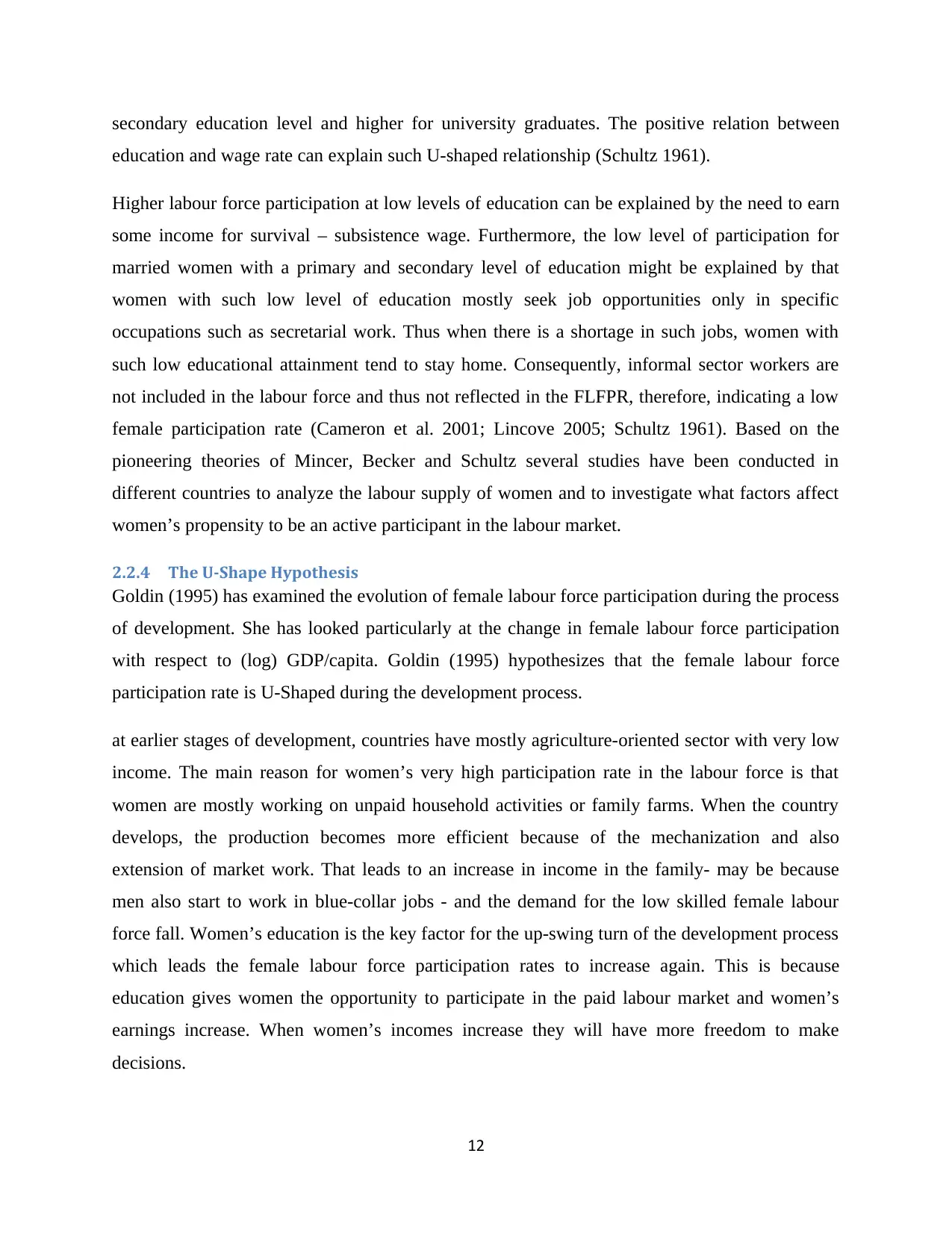
secondary education level and higher for university graduates. The positive relation between
education and wage rate can explain such U-shaped relationship (Schultz 1961).
Higher labour force participation at low levels of education can be explained by the need to earn
some income for survival – subsistence wage. Furthermore, the low level of participation for
married women with a primary and secondary level of education might be explained by that
women with such low level of education mostly seek job opportunities only in specific
occupations such as secretarial work. Thus when there is a shortage in such jobs, women with
such low educational attainment tend to stay home. Consequently, informal sector workers are
not included in the labour force and thus not reflected in the FLFPR, therefore, indicating a low
female participation rate (Cameron et al. 2001; Lincove 2005; Schultz 1961). Based on the
pioneering theories of Mincer, Becker and Schultz several studies have been conducted in
different countries to analyze the labour supply of women and to investigate what factors affect
women’s propensity to be an active participant in the labour market.
2.2.4 The U-Shape Hypothesis
Goldin (1995) has examined the evolution of female labour force participation during the process
of development. She has looked particularly at the change in female labour force participation
with respect to (log) GDP/capita. Goldin (1995) hypothesizes that the female labour force
participation rate is U-Shaped during the development process.
at earlier stages of development, countries have mostly agriculture-oriented sector with very low
income. The main reason for women’s very high participation rate in the labour force is that
women are mostly working on unpaid household activities or family farms. When the country
develops, the production becomes more efficient because of the mechanization and also
extension of market work. That leads to an increase in income in the family- may be because
men also start to work in blue-collar jobs - and the demand for the low skilled female labour
force fall. Women’s education is the key factor for the up-swing turn of the development process
which leads the female labour force participation rates to increase again. This is because
education gives women the opportunity to participate in the paid labour market and women’s
earnings increase. When women’s incomes increase they will have more freedom to make
decisions.
12
education and wage rate can explain such U-shaped relationship (Schultz 1961).
Higher labour force participation at low levels of education can be explained by the need to earn
some income for survival – subsistence wage. Furthermore, the low level of participation for
married women with a primary and secondary level of education might be explained by that
women with such low level of education mostly seek job opportunities only in specific
occupations such as secretarial work. Thus when there is a shortage in such jobs, women with
such low educational attainment tend to stay home. Consequently, informal sector workers are
not included in the labour force and thus not reflected in the FLFPR, therefore, indicating a low
female participation rate (Cameron et al. 2001; Lincove 2005; Schultz 1961). Based on the
pioneering theories of Mincer, Becker and Schultz several studies have been conducted in
different countries to analyze the labour supply of women and to investigate what factors affect
women’s propensity to be an active participant in the labour market.
2.2.4 The U-Shape Hypothesis
Goldin (1995) has examined the evolution of female labour force participation during the process
of development. She has looked particularly at the change in female labour force participation
with respect to (log) GDP/capita. Goldin (1995) hypothesizes that the female labour force
participation rate is U-Shaped during the development process.
at earlier stages of development, countries have mostly agriculture-oriented sector with very low
income. The main reason for women’s very high participation rate in the labour force is that
women are mostly working on unpaid household activities or family farms. When the country
develops, the production becomes more efficient because of the mechanization and also
extension of market work. That leads to an increase in income in the family- may be because
men also start to work in blue-collar jobs - and the demand for the low skilled female labour
force fall. Women’s education is the key factor for the up-swing turn of the development process
which leads the female labour force participation rates to increase again. This is because
education gives women the opportunity to participate in the paid labour market and women’s
earnings increase. When women’s incomes increase they will have more freedom to make
decisions.
12
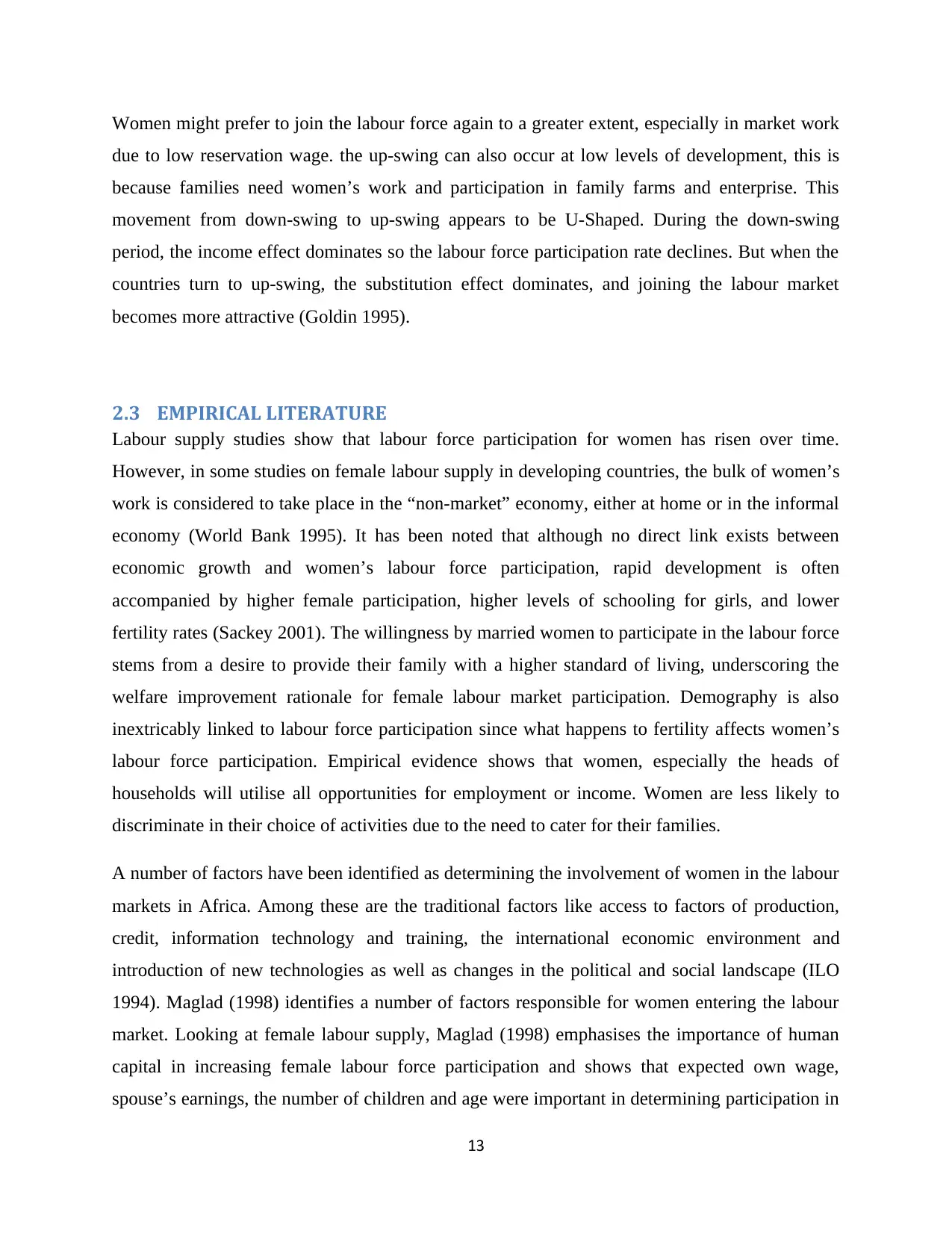
Women might prefer to join the labour force again to a greater extent, especially in market work
due to low reservation wage. the up-swing can also occur at low levels of development, this is
because families need women’s work and participation in family farms and enterprise. This
movement from down-swing to up-swing appears to be U-Shaped. During the down-swing
period, the income effect dominates so the labour force participation rate declines. But when the
countries turn to up-swing, the substitution effect dominates, and joining the labour market
becomes more attractive (Goldin 1995).
2.3 EMPIRICAL LITERATURE
Labour supply studies show that labour force participation for women has risen over time.
However, in some studies on female labour supply in developing countries, the bulk of women’s
work is considered to take place in the “non-market” economy, either at home or in the informal
economy (World Bank 1995). It has been noted that although no direct link exists between
economic growth and women’s labour force participation, rapid development is often
accompanied by higher female participation, higher levels of schooling for girls, and lower
fertility rates (Sackey 2001). The willingness by married women to participate in the labour force
stems from a desire to provide their family with a higher standard of living, underscoring the
welfare improvement rationale for female labour market participation. Demography is also
inextricably linked to labour force participation since what happens to fertility affects women’s
labour force participation. Empirical evidence shows that women, especially the heads of
households will utilise all opportunities for employment or income. Women are less likely to
discriminate in their choice of activities due to the need to cater for their families.
A number of factors have been identified as determining the involvement of women in the labour
markets in Africa. Among these are the traditional factors like access to factors of production,
credit, information technology and training, the international economic environment and
introduction of new technologies as well as changes in the political and social landscape (ILO
1994). Maglad (1998) identifies a number of factors responsible for women entering the labour
market. Looking at female labour supply, Maglad (1998) emphasises the importance of human
capital in increasing female labour force participation and shows that expected own wage,
spouse’s earnings, the number of children and age were important in determining participation in
13
due to low reservation wage. the up-swing can also occur at low levels of development, this is
because families need women’s work and participation in family farms and enterprise. This
movement from down-swing to up-swing appears to be U-Shaped. During the down-swing
period, the income effect dominates so the labour force participation rate declines. But when the
countries turn to up-swing, the substitution effect dominates, and joining the labour market
becomes more attractive (Goldin 1995).
2.3 EMPIRICAL LITERATURE
Labour supply studies show that labour force participation for women has risen over time.
However, in some studies on female labour supply in developing countries, the bulk of women’s
work is considered to take place in the “non-market” economy, either at home or in the informal
economy (World Bank 1995). It has been noted that although no direct link exists between
economic growth and women’s labour force participation, rapid development is often
accompanied by higher female participation, higher levels of schooling for girls, and lower
fertility rates (Sackey 2001). The willingness by married women to participate in the labour force
stems from a desire to provide their family with a higher standard of living, underscoring the
welfare improvement rationale for female labour market participation. Demography is also
inextricably linked to labour force participation since what happens to fertility affects women’s
labour force participation. Empirical evidence shows that women, especially the heads of
households will utilise all opportunities for employment or income. Women are less likely to
discriminate in their choice of activities due to the need to cater for their families.
A number of factors have been identified as determining the involvement of women in the labour
markets in Africa. Among these are the traditional factors like access to factors of production,
credit, information technology and training, the international economic environment and
introduction of new technologies as well as changes in the political and social landscape (ILO
1994). Maglad (1998) identifies a number of factors responsible for women entering the labour
market. Looking at female labour supply, Maglad (1998) emphasises the importance of human
capital in increasing female labour force participation and shows that expected own wage,
spouse’s earnings, the number of children and age were important in determining participation in
13
Paraphrase This Document
Need a fresh take? Get an instant paraphrase of this document with our AI Paraphraser
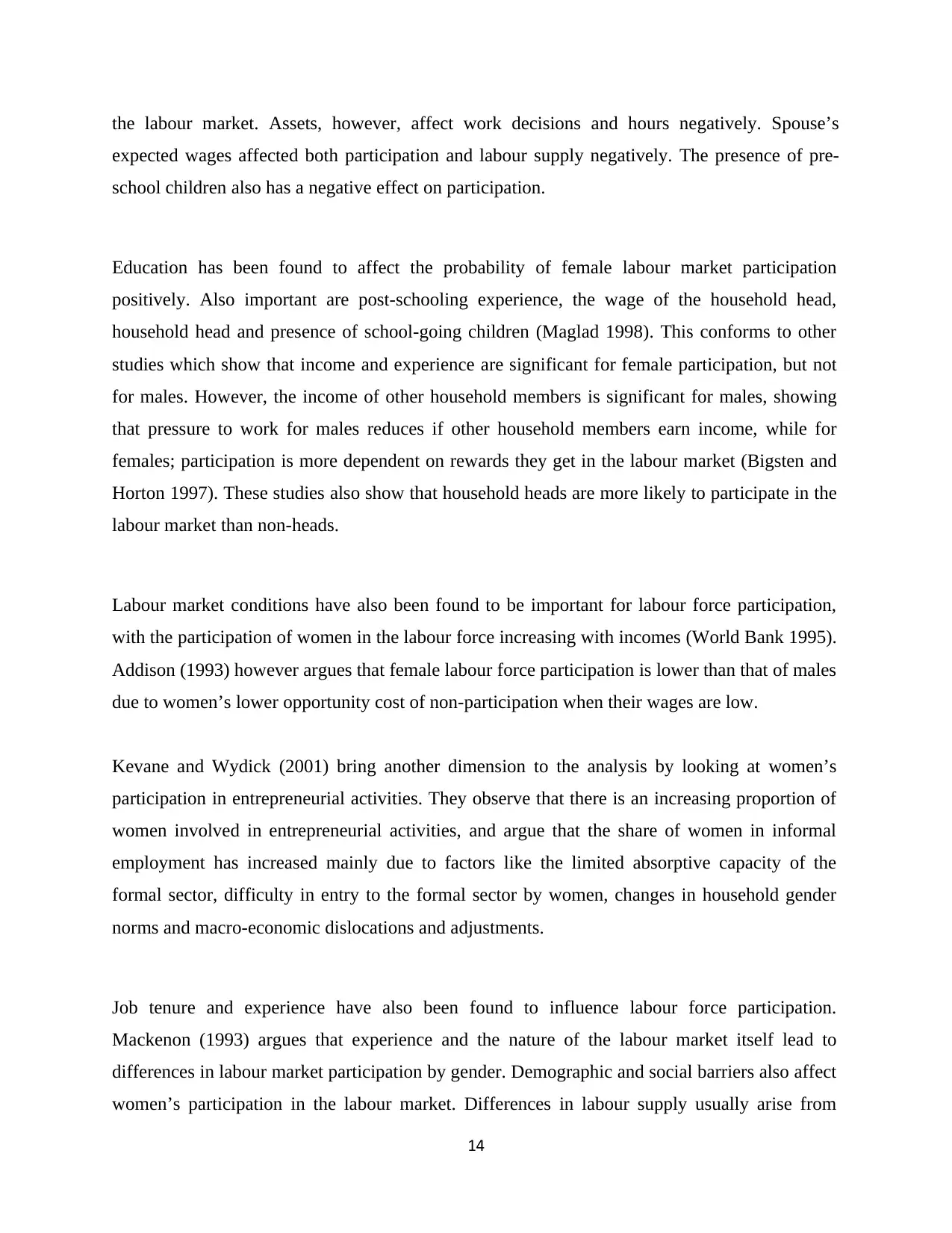
the labour market. Assets, however, affect work decisions and hours negatively. Spouse’s
expected wages affected both participation and labour supply negatively. The presence of pre-
school children also has a negative effect on participation.
Education has been found to affect the probability of female labour market participation
positively. Also important are post-schooling experience, the wage of the household head,
household head and presence of school-going children (Maglad 1998). This conforms to other
studies which show that income and experience are significant for female participation, but not
for males. However, the income of other household members is significant for males, showing
that pressure to work for males reduces if other household members earn income, while for
females; participation is more dependent on rewards they get in the labour market (Bigsten and
Horton 1997). These studies also show that household heads are more likely to participate in the
labour market than non-heads.
Labour market conditions have also been found to be important for labour force participation,
with the participation of women in the labour force increasing with incomes (World Bank 1995).
Addison (1993) however argues that female labour force participation is lower than that of males
due to women’s lower opportunity cost of non-participation when their wages are low.
Kevane and Wydick (2001) bring another dimension to the analysis by looking at women’s
participation in entrepreneurial activities. They observe that there is an increasing proportion of
women involved in entrepreneurial activities, and argue that the share of women in informal
employment has increased mainly due to factors like the limited absorptive capacity of the
formal sector, difficulty in entry to the formal sector by women, changes in household gender
norms and macro-economic dislocations and adjustments.
Job tenure and experience have also been found to influence labour force participation.
Mackenon (1993) argues that experience and the nature of the labour market itself lead to
differences in labour market participation by gender. Demographic and social barriers also affect
women’s participation in the labour market. Differences in labour supply usually arise from
14
expected wages affected both participation and labour supply negatively. The presence of pre-
school children also has a negative effect on participation.
Education has been found to affect the probability of female labour market participation
positively. Also important are post-schooling experience, the wage of the household head,
household head and presence of school-going children (Maglad 1998). This conforms to other
studies which show that income and experience are significant for female participation, but not
for males. However, the income of other household members is significant for males, showing
that pressure to work for males reduces if other household members earn income, while for
females; participation is more dependent on rewards they get in the labour market (Bigsten and
Horton 1997). These studies also show that household heads are more likely to participate in the
labour market than non-heads.
Labour market conditions have also been found to be important for labour force participation,
with the participation of women in the labour force increasing with incomes (World Bank 1995).
Addison (1993) however argues that female labour force participation is lower than that of males
due to women’s lower opportunity cost of non-participation when their wages are low.
Kevane and Wydick (2001) bring another dimension to the analysis by looking at women’s
participation in entrepreneurial activities. They observe that there is an increasing proportion of
women involved in entrepreneurial activities, and argue that the share of women in informal
employment has increased mainly due to factors like the limited absorptive capacity of the
formal sector, difficulty in entry to the formal sector by women, changes in household gender
norms and macro-economic dislocations and adjustments.
Job tenure and experience have also been found to influence labour force participation.
Mackenon (1993) argues that experience and the nature of the labour market itself lead to
differences in labour market participation by gender. Demographic and social barriers also affect
women’s participation in the labour market. Differences in labour supply usually arise from
14
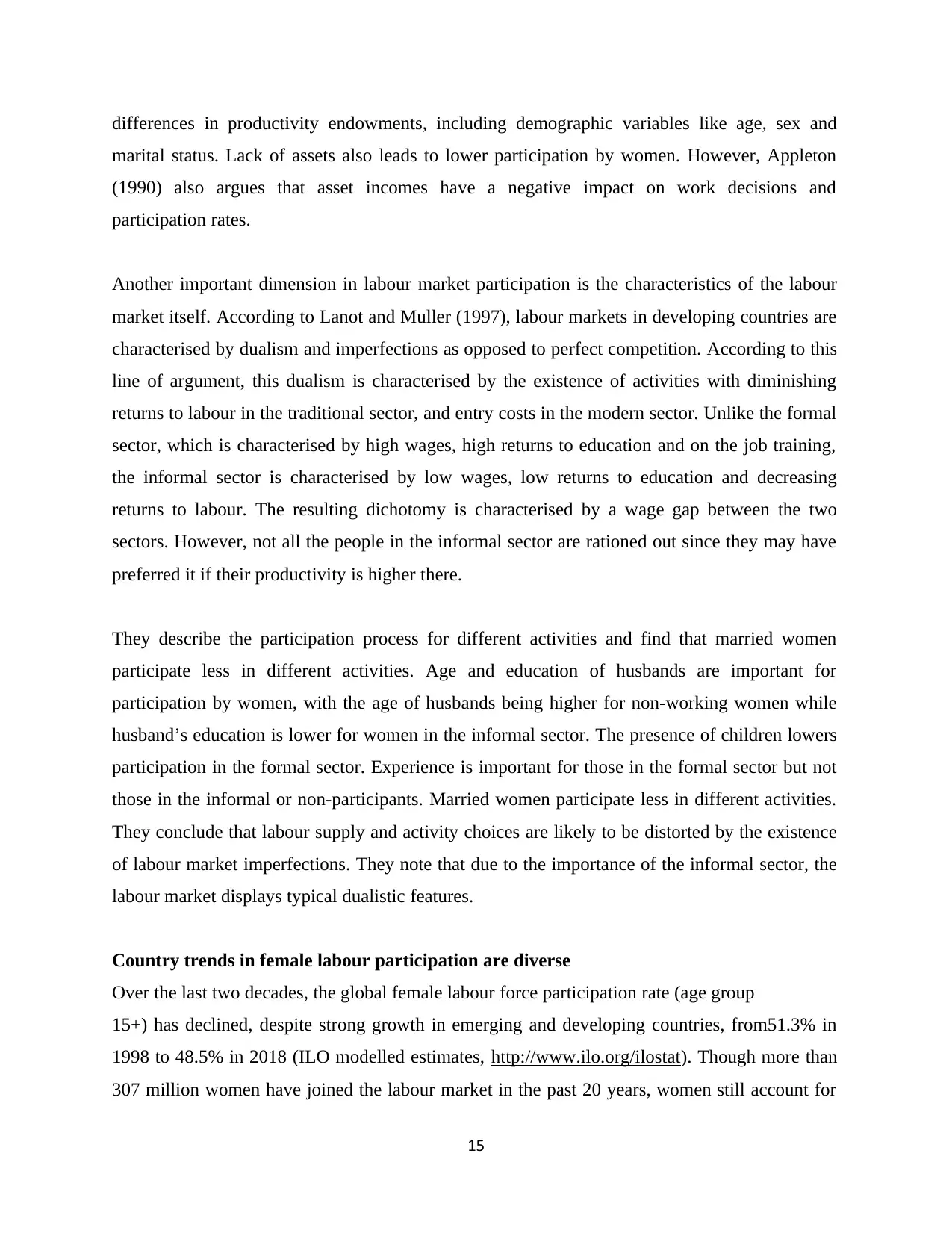
differences in productivity endowments, including demographic variables like age, sex and
marital status. Lack of assets also leads to lower participation by women. However, Appleton
(1990) also argues that asset incomes have a negative impact on work decisions and
participation rates.
Another important dimension in labour market participation is the characteristics of the labour
market itself. According to Lanot and Muller (1997), labour markets in developing countries are
characterised by dualism and imperfections as opposed to perfect competition. According to this
line of argument, this dualism is characterised by the existence of activities with diminishing
returns to labour in the traditional sector, and entry costs in the modern sector. Unlike the formal
sector, which is characterised by high wages, high returns to education and on the job training,
the informal sector is characterised by low wages, low returns to education and decreasing
returns to labour. The resulting dichotomy is characterised by a wage gap between the two
sectors. However, not all the people in the informal sector are rationed out since they may have
preferred it if their productivity is higher there.
They describe the participation process for different activities and find that married women
participate less in different activities. Age and education of husbands are important for
participation by women, with the age of husbands being higher for non-working women while
husband’s education is lower for women in the informal sector. The presence of children lowers
participation in the formal sector. Experience is important for those in the formal sector but not
those in the informal or non-participants. Married women participate less in different activities.
They conclude that labour supply and activity choices are likely to be distorted by the existence
of labour market imperfections. They note that due to the importance of the informal sector, the
labour market displays typical dualistic features.
Country trends in female labour participation are diverse
Over the last two decades, the global female labour force participation rate (age group
15+) has declined, despite strong growth in emerging and developing countries, from51.3% in
1998 to 48.5% in 2018 (ILO modelled estimates, http://www.ilo.org/ilostat). Though more than
307 million women have joined the labour market in the past 20 years, women still account for
15
marital status. Lack of assets also leads to lower participation by women. However, Appleton
(1990) also argues that asset incomes have a negative impact on work decisions and
participation rates.
Another important dimension in labour market participation is the characteristics of the labour
market itself. According to Lanot and Muller (1997), labour markets in developing countries are
characterised by dualism and imperfections as opposed to perfect competition. According to this
line of argument, this dualism is characterised by the existence of activities with diminishing
returns to labour in the traditional sector, and entry costs in the modern sector. Unlike the formal
sector, which is characterised by high wages, high returns to education and on the job training,
the informal sector is characterised by low wages, low returns to education and decreasing
returns to labour. The resulting dichotomy is characterised by a wage gap between the two
sectors. However, not all the people in the informal sector are rationed out since they may have
preferred it if their productivity is higher there.
They describe the participation process for different activities and find that married women
participate less in different activities. Age and education of husbands are important for
participation by women, with the age of husbands being higher for non-working women while
husband’s education is lower for women in the informal sector. The presence of children lowers
participation in the formal sector. Experience is important for those in the formal sector but not
those in the informal or non-participants. Married women participate less in different activities.
They conclude that labour supply and activity choices are likely to be distorted by the existence
of labour market imperfections. They note that due to the importance of the informal sector, the
labour market displays typical dualistic features.
Country trends in female labour participation are diverse
Over the last two decades, the global female labour force participation rate (age group
15+) has declined, despite strong growth in emerging and developing countries, from51.3% in
1998 to 48.5% in 2018 (ILO modelled estimates, http://www.ilo.org/ilostat). Though more than
307 million women have joined the labour market in the past 20 years, women still account for
15
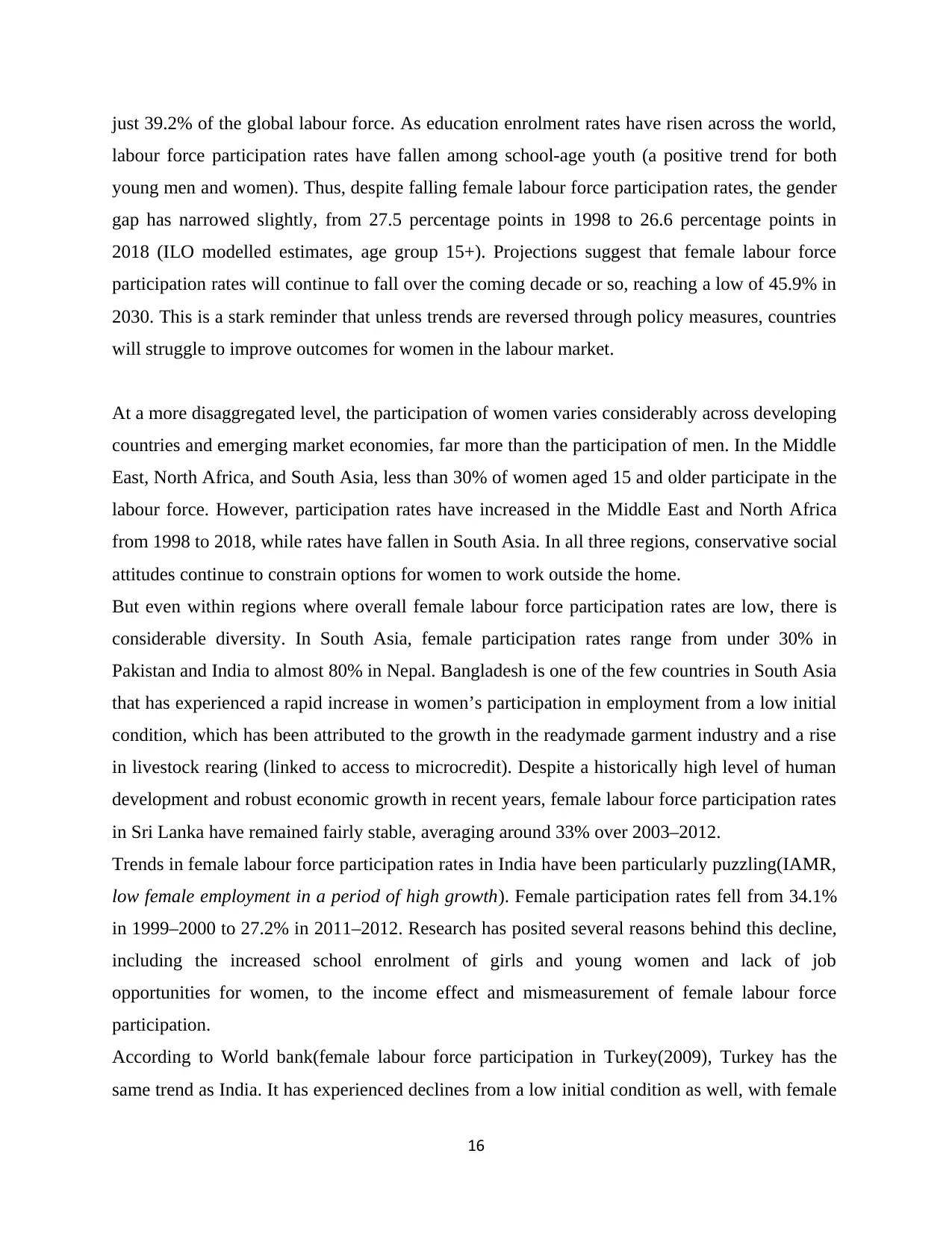
just 39.2% of the global labour force. As education enrolment rates have risen across the world,
labour force participation rates have fallen among school-age youth (a positive trend for both
young men and women). Thus, despite falling female labour force participation rates, the gender
gap has narrowed slightly, from 27.5 percentage points in 1998 to 26.6 percentage points in
2018 (ILO modelled estimates, age group 15+). Projections suggest that female labour force
participation rates will continue to fall over the coming decade or so, reaching a low of 45.9% in
2030. This is a stark reminder that unless trends are reversed through policy measures, countries
will struggle to improve outcomes for women in the labour market.
At a more disaggregated level, the participation of women varies considerably across developing
countries and emerging market economies, far more than the participation of men. In the Middle
East, North Africa, and South Asia, less than 30% of women aged 15 and older participate in the
labour force. However, participation rates have increased in the Middle East and North Africa
from 1998 to 2018, while rates have fallen in South Asia. In all three regions, conservative social
attitudes continue to constrain options for women to work outside the home.
But even within regions where overall female labour force participation rates are low, there is
considerable diversity. In South Asia, female participation rates range from under 30% in
Pakistan and India to almost 80% in Nepal. Bangladesh is one of the few countries in South Asia
that has experienced a rapid increase in women’s participation in employment from a low initial
condition, which has been attributed to the growth in the readymade garment industry and a rise
in livestock rearing (linked to access to microcredit). Despite a historically high level of human
development and robust economic growth in recent years, female labour force participation rates
in Sri Lanka have remained fairly stable, averaging around 33% over 2003–2012.
Trends in female labour force participation rates in India have been particularly puzzling(IAMR,
low female employment in a period of high growth). Female participation rates fell from 34.1%
in 1999–2000 to 27.2% in 2011–2012. Research has posited several reasons behind this decline,
including the increased school enrolment of girls and young women and lack of job
opportunities for women, to the income effect and mismeasurement of female labour force
participation.
According to World bank(female labour force participation in Turkey(2009), Turkey has the
same trend as India. It has experienced declines from a low initial condition as well, with female
16
labour force participation rates have fallen among school-age youth (a positive trend for both
young men and women). Thus, despite falling female labour force participation rates, the gender
gap has narrowed slightly, from 27.5 percentage points in 1998 to 26.6 percentage points in
2018 (ILO modelled estimates, age group 15+). Projections suggest that female labour force
participation rates will continue to fall over the coming decade or so, reaching a low of 45.9% in
2030. This is a stark reminder that unless trends are reversed through policy measures, countries
will struggle to improve outcomes for women in the labour market.
At a more disaggregated level, the participation of women varies considerably across developing
countries and emerging market economies, far more than the participation of men. In the Middle
East, North Africa, and South Asia, less than 30% of women aged 15 and older participate in the
labour force. However, participation rates have increased in the Middle East and North Africa
from 1998 to 2018, while rates have fallen in South Asia. In all three regions, conservative social
attitudes continue to constrain options for women to work outside the home.
But even within regions where overall female labour force participation rates are low, there is
considerable diversity. In South Asia, female participation rates range from under 30% in
Pakistan and India to almost 80% in Nepal. Bangladesh is one of the few countries in South Asia
that has experienced a rapid increase in women’s participation in employment from a low initial
condition, which has been attributed to the growth in the readymade garment industry and a rise
in livestock rearing (linked to access to microcredit). Despite a historically high level of human
development and robust economic growth in recent years, female labour force participation rates
in Sri Lanka have remained fairly stable, averaging around 33% over 2003–2012.
Trends in female labour force participation rates in India have been particularly puzzling(IAMR,
low female employment in a period of high growth). Female participation rates fell from 34.1%
in 1999–2000 to 27.2% in 2011–2012. Research has posited several reasons behind this decline,
including the increased school enrolment of girls and young women and lack of job
opportunities for women, to the income effect and mismeasurement of female labour force
participation.
According to World bank(female labour force participation in Turkey(2009), Turkey has the
same trend as India. It has experienced declines from a low initial condition as well, with female
16
Secure Best Marks with AI Grader
Need help grading? Try our AI Grader for instant feedback on your assignments.
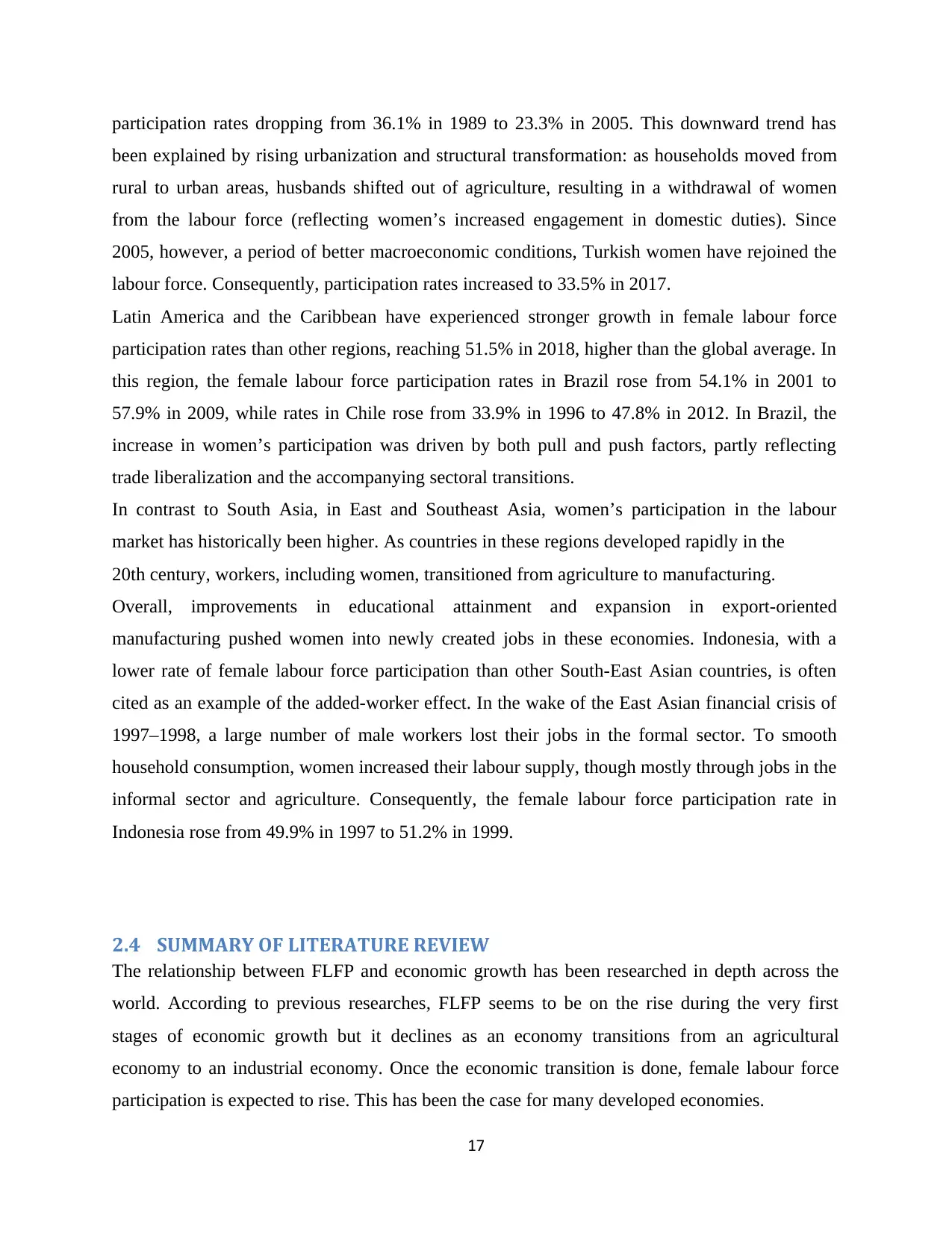
participation rates dropping from 36.1% in 1989 to 23.3% in 2005. This downward trend has
been explained by rising urbanization and structural transformation: as households moved from
rural to urban areas, husbands shifted out of agriculture, resulting in a withdrawal of women
from the labour force (reflecting women’s increased engagement in domestic duties). Since
2005, however, a period of better macroeconomic conditions, Turkish women have rejoined the
labour force. Consequently, participation rates increased to 33.5% in 2017.
Latin America and the Caribbean have experienced stronger growth in female labour force
participation rates than other regions, reaching 51.5% in 2018, higher than the global average. In
this region, the female labour force participation rates in Brazil rose from 54.1% in 2001 to
57.9% in 2009, while rates in Chile rose from 33.9% in 1996 to 47.8% in 2012. In Brazil, the
increase in women’s participation was driven by both pull and push factors, partly reflecting
trade liberalization and the accompanying sectoral transitions.
In contrast to South Asia, in East and Southeast Asia, women’s participation in the labour
market has historically been higher. As countries in these regions developed rapidly in the
20th century, workers, including women, transitioned from agriculture to manufacturing.
Overall, improvements in educational attainment and expansion in export-oriented
manufacturing pushed women into newly created jobs in these economies. Indonesia, with a
lower rate of female labour force participation than other South-East Asian countries, is often
cited as an example of the added-worker effect. In the wake of the East Asian financial crisis of
1997–1998, a large number of male workers lost their jobs in the formal sector. To smooth
household consumption, women increased their labour supply, though mostly through jobs in the
informal sector and agriculture. Consequently, the female labour force participation rate in
Indonesia rose from 49.9% in 1997 to 51.2% in 1999.
2.4 SUMMARY OF LITERATURE REVIEW
The relationship between FLFP and economic growth has been researched in depth across the
world. According to previous researches, FLFP seems to be on the rise during the very first
stages of economic growth but it declines as an economy transitions from an agricultural
economy to an industrial economy. Once the economic transition is done, female labour force
participation is expected to rise. This has been the case for many developed economies.
17
been explained by rising urbanization and structural transformation: as households moved from
rural to urban areas, husbands shifted out of agriculture, resulting in a withdrawal of women
from the labour force (reflecting women’s increased engagement in domestic duties). Since
2005, however, a period of better macroeconomic conditions, Turkish women have rejoined the
labour force. Consequently, participation rates increased to 33.5% in 2017.
Latin America and the Caribbean have experienced stronger growth in female labour force
participation rates than other regions, reaching 51.5% in 2018, higher than the global average. In
this region, the female labour force participation rates in Brazil rose from 54.1% in 2001 to
57.9% in 2009, while rates in Chile rose from 33.9% in 1996 to 47.8% in 2012. In Brazil, the
increase in women’s participation was driven by both pull and push factors, partly reflecting
trade liberalization and the accompanying sectoral transitions.
In contrast to South Asia, in East and Southeast Asia, women’s participation in the labour
market has historically been higher. As countries in these regions developed rapidly in the
20th century, workers, including women, transitioned from agriculture to manufacturing.
Overall, improvements in educational attainment and expansion in export-oriented
manufacturing pushed women into newly created jobs in these economies. Indonesia, with a
lower rate of female labour force participation than other South-East Asian countries, is often
cited as an example of the added-worker effect. In the wake of the East Asian financial crisis of
1997–1998, a large number of male workers lost their jobs in the formal sector. To smooth
household consumption, women increased their labour supply, though mostly through jobs in the
informal sector and agriculture. Consequently, the female labour force participation rate in
Indonesia rose from 49.9% in 1997 to 51.2% in 1999.
2.4 SUMMARY OF LITERATURE REVIEW
The relationship between FLFP and economic growth has been researched in depth across the
world. According to previous researches, FLFP seems to be on the rise during the very first
stages of economic growth but it declines as an economy transitions from an agricultural
economy to an industrial economy. Once the economic transition is done, female labour force
participation is expected to rise. This has been the case for many developed economies.
17
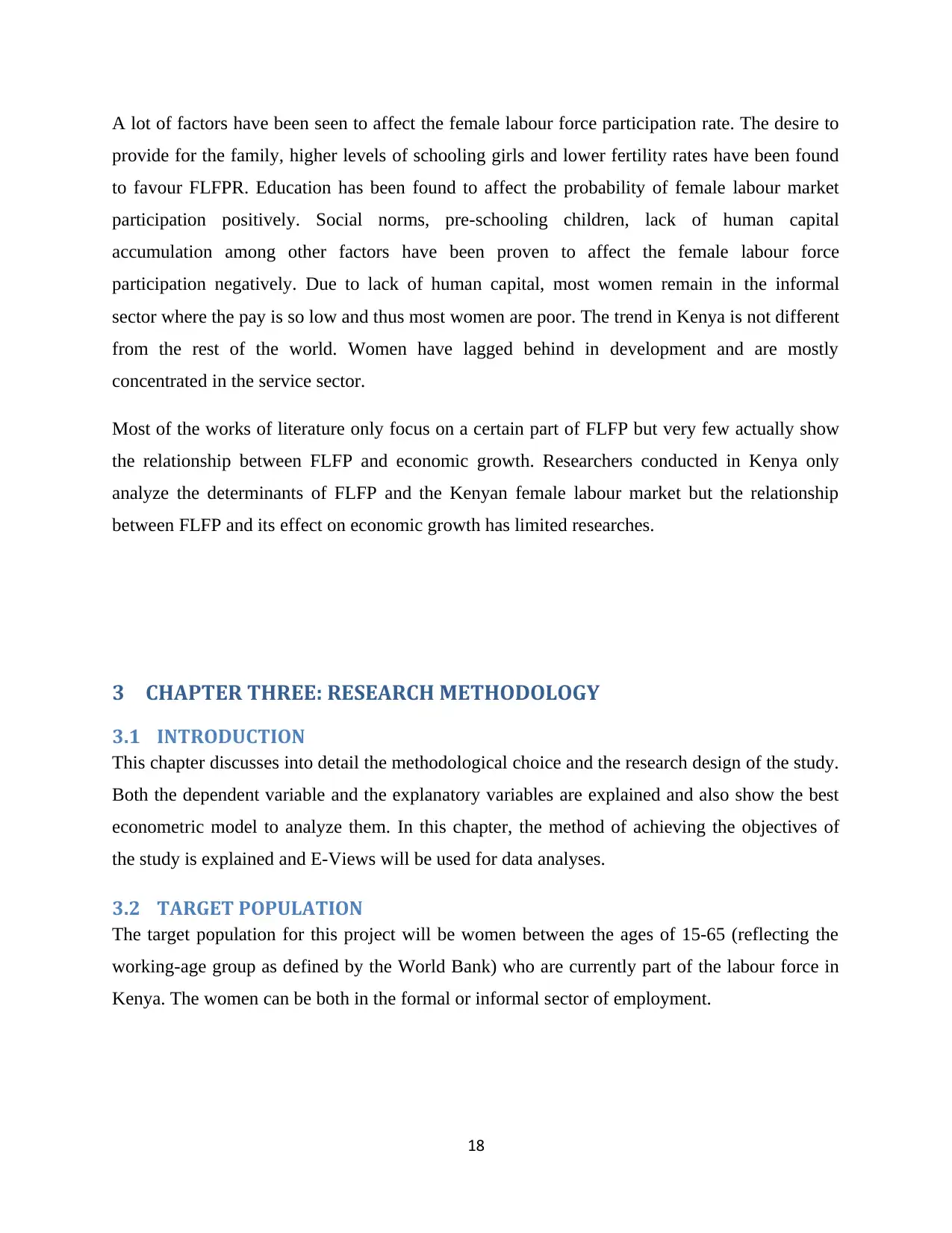
A lot of factors have been seen to affect the female labour force participation rate. The desire to
provide for the family, higher levels of schooling girls and lower fertility rates have been found
to favour FLFPR. Education has been found to affect the probability of female labour market
participation positively. Social norms, pre-schooling children, lack of human capital
accumulation among other factors have been proven to affect the female labour force
participation negatively. Due to lack of human capital, most women remain in the informal
sector where the pay is so low and thus most women are poor. The trend in Kenya is not different
from the rest of the world. Women have lagged behind in development and are mostly
concentrated in the service sector.
Most of the works of literature only focus on a certain part of FLFP but very few actually show
the relationship between FLFP and economic growth. Researchers conducted in Kenya only
analyze the determinants of FLFP and the Kenyan female labour market but the relationship
between FLFP and its effect on economic growth has limited researches.
3 CHAPTER THREE: RESEARCH METHODOLOGY
3.1 INTRODUCTION
This chapter discusses into detail the methodological choice and the research design of the study.
Both the dependent variable and the explanatory variables are explained and also show the best
econometric model to analyze them. In this chapter, the method of achieving the objectives of
the study is explained and E-Views will be used for data analyses.
3.2 TARGET POPULATION
The target population for this project will be women between the ages of 15-65 (reflecting the
working-age group as defined by the World Bank) who are currently part of the labour force in
Kenya. The women can be both in the formal or informal sector of employment.
18
provide for the family, higher levels of schooling girls and lower fertility rates have been found
to favour FLFPR. Education has been found to affect the probability of female labour market
participation positively. Social norms, pre-schooling children, lack of human capital
accumulation among other factors have been proven to affect the female labour force
participation negatively. Due to lack of human capital, most women remain in the informal
sector where the pay is so low and thus most women are poor. The trend in Kenya is not different
from the rest of the world. Women have lagged behind in development and are mostly
concentrated in the service sector.
Most of the works of literature only focus on a certain part of FLFP but very few actually show
the relationship between FLFP and economic growth. Researchers conducted in Kenya only
analyze the determinants of FLFP and the Kenyan female labour market but the relationship
between FLFP and its effect on economic growth has limited researches.
3 CHAPTER THREE: RESEARCH METHODOLOGY
3.1 INTRODUCTION
This chapter discusses into detail the methodological choice and the research design of the study.
Both the dependent variable and the explanatory variables are explained and also show the best
econometric model to analyze them. In this chapter, the method of achieving the objectives of
the study is explained and E-Views will be used for data analyses.
3.2 TARGET POPULATION
The target population for this project will be women between the ages of 15-65 (reflecting the
working-age group as defined by the World Bank) who are currently part of the labour force in
Kenya. The women can be both in the formal or informal sector of employment.
18
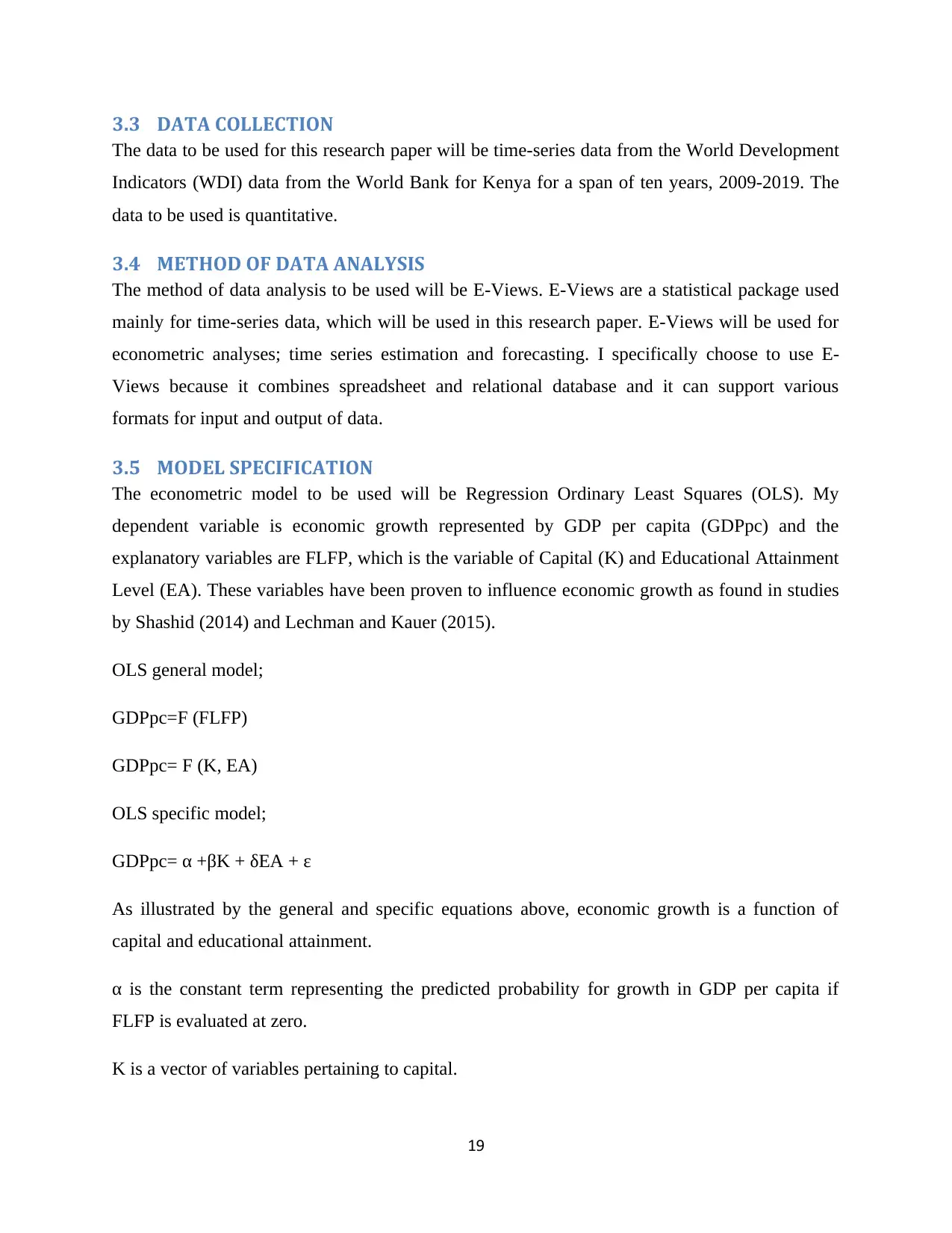
3.3 DATA COLLECTION
The data to be used for this research paper will be time-series data from the World Development
Indicators (WDI) data from the World Bank for Kenya for a span of ten years, 2009-2019. The
data to be used is quantitative.
3.4 METHOD OF DATA ANALYSIS
The method of data analysis to be used will be E-Views. E-Views are a statistical package used
mainly for time-series data, which will be used in this research paper. E-Views will be used for
econometric analyses; time series estimation and forecasting. I specifically choose to use E-
Views because it combines spreadsheet and relational database and it can support various
formats for input and output of data.
3.5 MODEL SPECIFICATION
The econometric model to be used will be Regression Ordinary Least Squares (OLS). My
dependent variable is economic growth represented by GDP per capita (GDPpc) and the
explanatory variables are FLFP, which is the variable of Capital (K) and Educational Attainment
Level (EA). These variables have been proven to influence economic growth as found in studies
by Shashid (2014) and Lechman and Kauer (2015).
OLS general model;
GDPpc=F (FLFP)
GDPpc= F (K, EA)
OLS specific model;
GDPpc= α +βK + δEA + ε
As illustrated by the general and specific equations above, economic growth is a function of
capital and educational attainment.
α is the constant term representing the predicted probability for growth in GDP per capita if
FLFP is evaluated at zero.
K is a vector of variables pertaining to capital.
19
The data to be used for this research paper will be time-series data from the World Development
Indicators (WDI) data from the World Bank for Kenya for a span of ten years, 2009-2019. The
data to be used is quantitative.
3.4 METHOD OF DATA ANALYSIS
The method of data analysis to be used will be E-Views. E-Views are a statistical package used
mainly for time-series data, which will be used in this research paper. E-Views will be used for
econometric analyses; time series estimation and forecasting. I specifically choose to use E-
Views because it combines spreadsheet and relational database and it can support various
formats for input and output of data.
3.5 MODEL SPECIFICATION
The econometric model to be used will be Regression Ordinary Least Squares (OLS). My
dependent variable is economic growth represented by GDP per capita (GDPpc) and the
explanatory variables are FLFP, which is the variable of Capital (K) and Educational Attainment
Level (EA). These variables have been proven to influence economic growth as found in studies
by Shashid (2014) and Lechman and Kauer (2015).
OLS general model;
GDPpc=F (FLFP)
GDPpc= F (K, EA)
OLS specific model;
GDPpc= α +βK + δEA + ε
As illustrated by the general and specific equations above, economic growth is a function of
capital and educational attainment.
α is the constant term representing the predicted probability for growth in GDP per capita if
FLFP is evaluated at zero.
K is a vector of variables pertaining to capital.
19
Paraphrase This Document
Need a fresh take? Get an instant paraphrase of this document with our AI Paraphraser
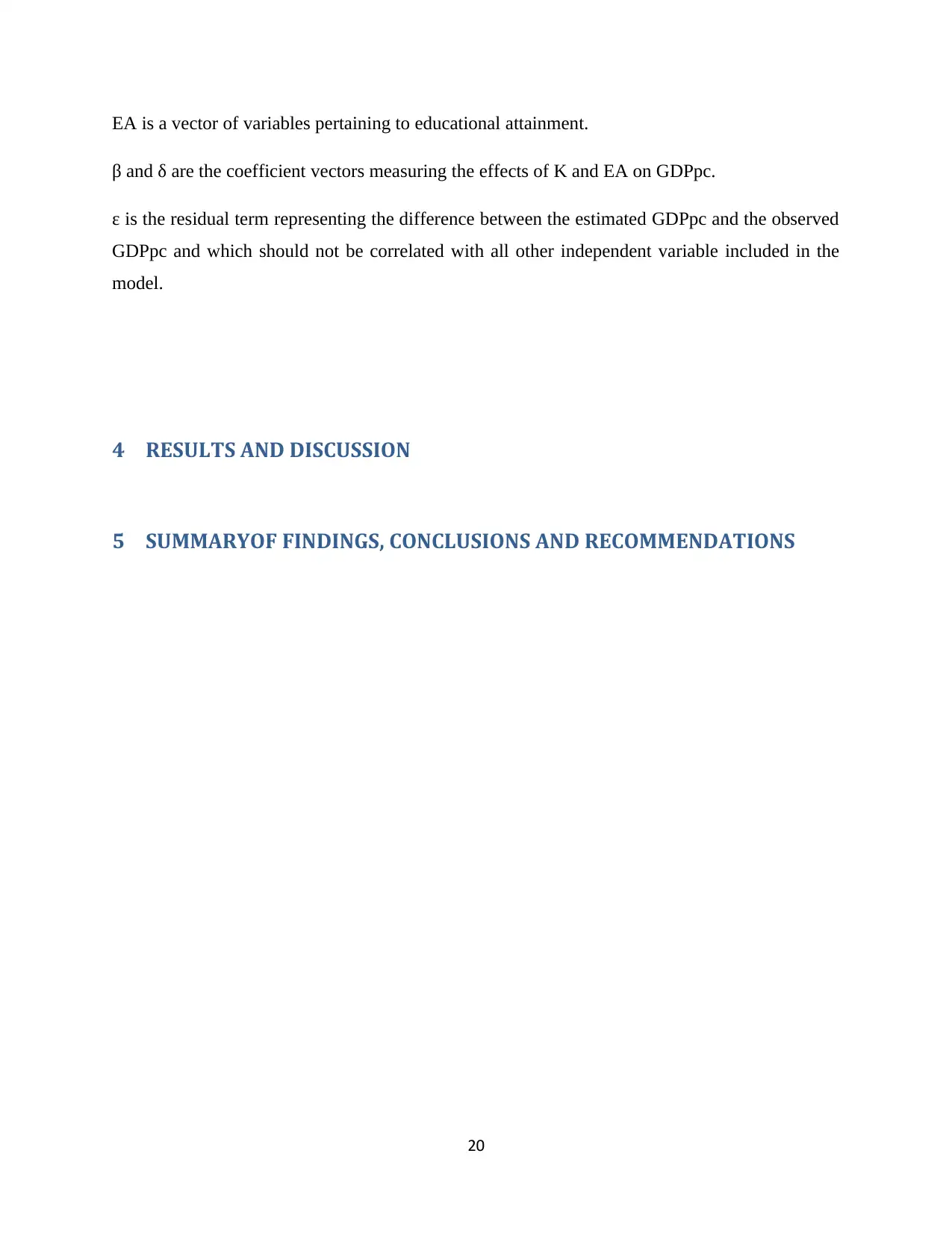
EA is a vector of variables pertaining to educational attainment.
β and δ are the coefficient vectors measuring the effects of K and EA on GDPpc.
ε is the residual term representing the difference between the estimated GDPpc and the observed
GDPpc and which should not be correlated with all other independent variable included in the
model.
4 RESULTS AND DISCUSSION
5 SUMMARYOF FINDINGS, CONCLUSIONS AND RECOMMENDATIONS
20
β and δ are the coefficient vectors measuring the effects of K and EA on GDPpc.
ε is the residual term representing the difference between the estimated GDPpc and the observed
GDPpc and which should not be correlated with all other independent variable included in the
model.
4 RESULTS AND DISCUSSION
5 SUMMARYOF FINDINGS, CONCLUSIONS AND RECOMMENDATIONS
20
1 out of 26
Your All-in-One AI-Powered Toolkit for Academic Success.
+13062052269
info@desklib.com
Available 24*7 on WhatsApp / Email
![[object Object]](/_next/static/media/star-bottom.7253800d.svg)
Unlock your academic potential
© 2024 | Zucol Services PVT LTD | All rights reserved.
